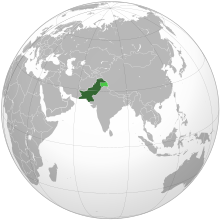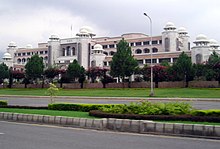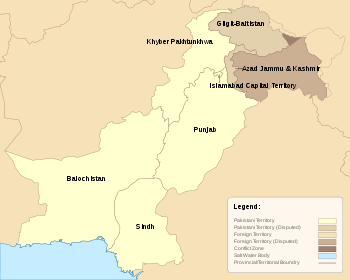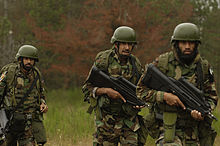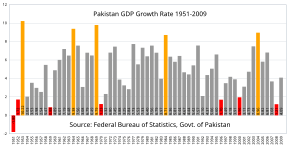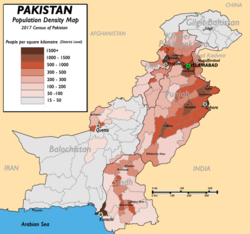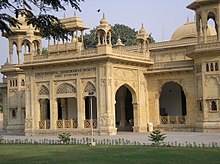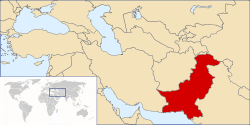Pakistan
Pakistan![Pakistan Pakistan]()
Pakistan (![]() i /ˈpækɪstæn/ or
i /ˈpækɪstæn/ or ![]() i /pɑːkiˈstɑːn/; Urdu: پاکِستان) (Urdu pronunciation: [paːkɪˈst̪aːn] (
i /pɑːkiˈstɑːn/; Urdu: پاکِستان) (Urdu pronunciation: [paːkɪˈst̪aːn] (![]() listen)), officially the Islamic Republic of Pakistan (Urdu: اسلامی جمہوریۂ پاکِستان) is a country in South Asia. It has a 1,046-kilometre (650 mi) coastline along the Arabian Sea and the Gulf of Oman in the south and is bordered by Afghanistan and Iran in the west, India in the east and China in the far northeast.[7] Tajikistan also lies very close to Pakistan but is separated by the narrow Wakhan Corridor. Strategically it is located in a position between the important regions of South Asia, Central Asia and the Middle East.[8]
listen)), officially the Islamic Republic of Pakistan (Urdu: اسلامی جمہوریۂ پاکِستان) is a country in South Asia. It has a 1,046-kilometre (650 mi) coastline along the Arabian Sea and the Gulf of Oman in the south and is bordered by Afghanistan and Iran in the west, India in the east and China in the far northeast.[7] Tajikistan also lies very close to Pakistan but is separated by the narrow Wakhan Corridor. Strategically it is located in a position between the important regions of South Asia, Central Asia and the Middle East.[8]
The region forming modern Pakistan was the site of several ancient cultures including the neolithic Mehrgarh and the bronze era Indus Valley Civilisation. Subsequently it was the recipient of Vedic, Persian, Indo-Greek, Islamic, Turco-Mongol, and Sikh cultures through several invasions and/or settlements. As a result the area has remained a part of numerous empires and dynasties including the Persian empires, Islamic caliphates and the Mauryan, Mongol, Mughal, Sikh and British Empires. Pakistan gained independence from the British Empire in 1947 after a struggle for independence, led by Mohammad Ali Jinnah, that sought independent states for the Muslim majority populations of the eastern and western regions of British India.[9] With the adoption of its constitution in 1956, Pakistan became an Islamic republic.[10] In 1971, an armed conflict in East Pakistan resulted in the creation of Bangladesh.[11]
Pakistan is a federal parliamentary republic consisting of four provinces and four federal territories. With over 170 million people, it is the sixth most populous country in the world[2] and has the second largest Muslim population after Indonesia.[12] It is an ethnically and linguistically diverse country with a similar variation in its geography and wildlife. With a semi-industrialized economy, it is the 27th largest in the world in terms of purchasing power. Since gaining independence, Pakistan’s history has been characterised by periods of military rule, political instability and conflicts with neighbouring India. The country faces challenging problems including extremism and terrorism, US involvement in local affairs,[13] poverty, illiteracy, and corruption.
Pakistan has the seventh largest standing armed force and is the only country with a Muslim majority to possess nuclear weapons. It is designated as a major non-NATO ally of the United States.[14] It is a founding member of the Organization of the Islamic Conference[15] and a member of the United Nations,[16] Commonwealth of Nations,[17] Next Eleven economies, and the G20 developing nations.
Etymology
The name Pakistan means Land of (the) Pure in Urdu and Persian. It was coined in 1934 as Pakstan by Choudhary Rahmat Ali, a Pakistan movement activist, who published it in his pamphlet Now or Never.[18] The name is a portmanteau representing the "thirty million Muslim brethren who live in PAKSTAN—by which we mean the five Northern units of India viz: Punjab, North-West Frontier Province (Afghan Province), Kashmir, Sind, and BaluchisTAN".[19] The letter ‘i’ was later added to ease pronunciation.
History
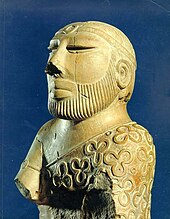
The Indus Priest/King wearing a Sindhi Ajruk, ca. 2500 BC.
The Indus region, which covers a considerable amount of Pakistan, was the site of several ancient cultures including the Neolithic era’s Mehrgarh and the bronze era Indus Valley Civilisation (2500–1500 BCE) at Harappa and Mohenjo-Daro.[20]
Waves of conquerors and migrants from the west—including Harappan, Indo-Aryans, Persians, Greeks, Sakas, Parthians, Kushans, Hephthalites, Afghans, Arabs, Turks and Mughals—settled in the region throughout the centuries, influencing the locals and being absorbed among them.[21] Ancient empires of the east—such as the Nandas, Mauryas, Sungas, Guptas and the Palas—ruled these territories at different times from Patliputra.[22]
However, in the medieval period, while the eastern provinces of Punjab and Sindh grew aligned with Indo-Islamic civilisation, the western areas became culturally allied with the Iranian civilisation of Afghanistan and Iran.[23] The region served as a crossroads of historic trade routes, including the Silk Road, and as a maritime entreport for the coastal trade between Mesopotamia and beyond up to Rome in the west and Malabar and beyond up to China in the east.[24]
Modern day Pakistan was at the heart of the Indus Valley Civilisation; that collapsed in the middle of the 2nd millennium BCE and was followed by the Vedic Civilisation, which also extended over much of the Indo-Gangetic plains. Successive ancient empires and kingdoms ruled the region: the Achaemenid Persian empire around 543 BCE,[25] the Greek empire founded by Alexander the Great in 326 BCE and the Mauryan empire founded by Chandragupta Maurya and extended by Ashoka the Great, until 185 BCE.[26]
The Indo-Greek Kingdom founded by Demetrius of Bactria included Gandhara and Punjab from 184 BCE, and reached its greatest extent under Menander, establishing the Greco-Buddhist period with advances in trade and culture. The city of Taxila (Takshashila) became a major centre of learning in ancient times—the remains of the city, located to the west of Islamabad, are one of the country’s major archaeological sites.[27] The Rai Dynasty (c.489–632) of Sindh, at its zenith, ruled this region and the surrounding territories.[28]

Menander I was a Bactrian ruler, who established an Indo-Greek Kingdom which existed in the territory of modern day Pakistan
In 712 CE, the Arab general Muhammad bin Qasim conquered Sindh and Multan in southern Punjab.[29] The Pakistan government’s official chronology states that "its foundation was laid” as a result of this conquest.[30] This Arab and Islamic victory would set the stage for several successive Muslim empires in South Asia, including the Ghaznavid Empire, the Ghorid Kingdom, the Delhi Sultanate and the Mughal Empire. During this period, Sufi missionaries played a pivotal role in converting a majority of the regional Buddhist and Hindu population to Islam.
The gradual decline of the Mughal Empire in the early eighteenth century provided opportunities for the Afghans, Balochis and Sikhs to exercise control over large areas until the British East India Company gained ascendancy over South Asia.[31] The Indian Rebellion of 1857, also known as the Sepoy Mutiny, was the region’s last major armed struggle against the British Raj, and it laid the foundations for the generally unarmed freedom struggle led by the Indian National Congress in the twentieth century. In the 1920s and 1930s, a movement led by the Hindu politician Mahatma Gandhi, and displaying commitment to long enshrined Hindu tenet of ahimsa, or non-violence, engaged millions of protesters in mass campaigns of civil disobedience.[32]

17th Century Badshahi Masjid built during Mughal rule
The All India Muslim League rose to popularity in the late 1930s amid fears of under-representation and neglect of Muslims in politics. On 29 December 1930, Allama Iqbal‘s presidential address called for an autonomous "state in northwestern India for Indian Muslims, within the body politic of India.”[33] Quaid e Azam Muhammad Ali Jinnah espoused the Two Nation Theory and led the Muslim League to adopt the Lahore Resolution of 1940, popularly known as the Pakistan Resolution. In early 1947, Britain announced the decision to end its rule in India. In June 1947, the nationalist leaders of British India—including Nehru and Abul Kalam Azad on behalf of the Congress, Jinnah representing the Muslim League, and Master Tara Singh representing the Sikhs—agreed to the proposed terms of transfer of power and independence.
The modern state of Pakistan was established on 14 August 1947 (27 Ramadan 1366 in the Islamic Calendar), carved out of the two Muslim-majority wings in the eastern and northwestern regions of British India and comprising the provinces of Balochistan, East Bengal, the North-West Frontier Province, West Punjab and Sindh.[34] The controversial, and ill-timed, division of the provinces of Punjab and Bengal caused communal riots across India and Pakistan—millions of Muslims moved to Pakistan and millions of Hindus and Sikhs moved to India.[35]
Disputes arose over several princely states including in the Muslim-majority Jammu and Kashmir, whose Hindu ruler had acceded to India following an invasion by Pashtun tribal militias, leading to the First Kashmir War in 1948.[36]

The Working Committee of the Muslim League in Lahore (1940)
From 1947 to 1956, Pakistan was a Dominion of Pakistan in the Commonwealth of Nations. It became a Republic in 1956, but the civilian rule was stalled by a coup d’état by General Ayub Khan, who was president during 1958–69, a period of internal instability and a second war with India in 1965. His successor, Yahya Khan (1969–71) had to deal with a devastating cyclone—which caused 500,000 deaths in East Pakistan—and also face a civil war in 1971. Economic grievances and political dissent in East Pakistan led to violent political tension and military repression that escalated into a civil war.[37] After nine months of guerrilla warfare between the Pakistan Army and the Indian backed Bengali Mukti Bahini militia, Indian intervention escalated into the Indo-Pakistani War of 1971, and ultimately to the secession of East Pakistan as the independent state of Bangladesh.[38]
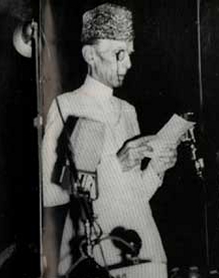
The first Governor General Muhammad Ali Jinnah delivering the opening address on 11 August 1947 to the new state of Pakistan.
Civilian rule resumed in Pakistan from 1972 to 1977 under Zulfikar Ali Bhutto, until he was deposed and later sentenced to death in 1979 by General Zia-ul-Haq, who became the country’s third military president. Zia introduced the Islamic Sharia legal code, which increased religious influences on the civil service and the military. With the death of President Zia in a plane crash in 1988, Benazir Bhutto, daughter of Zulfikar Ali Bhutto, was elected as the first female Prime Minister of Pakistan. Over the next decade, she fought for power with Nawaz Sharif as the country’s political and economic situation worsened. Pakistan got involved in the 1991 Gulf War and sent 5,000 troops as part of a U.S.-led coalition, specifically for the defence of Saudi Arabia.[39]
Military tensions in the Kargil conflict with India were followed by a Pakistani military coup d’état in 1999 in which General Pervez Musharraf assumed vast executive powers.[40][41] In 2001, Musharraf became President after the controversial resignation of Rafiq Tarar. After the 2002 parliamentary elections, Musharraf transferred executive powers to the newly elected Prime Minister Zafarullah Khan Jamali, who was succeeded in the 2004 prime-ministerial election by Shaukat Aziz. On 15 November 2007, the National Assembly, for the first time in Pakistan’s history, completed its tenure and new elections were called. The exiled political leaders Benazir Bhutto and Nawaz Sharif were permitted to return to Pakistan. However, the assassination of Benazir Bhutto during the election campaign in December led to postponement of elections and nationwide riots. Bhutto’s Pakistan Peoples Party (PPP) won the largest number of seats in the elections held in February 2008 and its member Yousaf Raza Gillani was sworn in as Prime Minister.[42] On 18 August 2008, Pervez Musharraf resigned from the presidency when threatened with impeachment,[43] and was succeeded by current president Asif Ali Zardari. By the end of 2009, more than 3 million Pakistani civilians have been displaced by the on going conflict in North-West Pakistan between the government and Taliban militants.[44]
Government and politics

Prime Minister of Pakistan, Yousaf Raza Gillani.
Pakistan is a democratic parliamentary federal republic with Islam as the state religion.[45] The first Constitution of Pakistan was adopted in 1956, but was suspended in 1958 by General Ayub Khan. The Constitution of 1973 – suspended in 1977, by Zia-ul-Haq, but re-instated in 1985 – is the country’s most important document, laying the foundations of the current government.[21]
The bicameral legislature comprises a 100-member Senate and a 342-member National Assembly. The President is the Head of state and the Commander-in-chief of the Armed Forces and is elected by an electoral college. The prime minister is usually the leader of the largest party in the National Assembly. Each province has a similar system of government with a directly elected Provincial Assembly in which the leader of the largest party or alliance becomes Chief Minister. Provincial Governors are appointed by the President.[45]
The Pakistani military has played an influential role in mainstream politics throughout Pakistan’s history, with military presidents ruling from 1958–71, 1977–88 and from 1999–2008.[46] The leftist Pakistan Peoples Party, led by Zulfikar Ali Bhutto, won support after the loss of East Pakistan but was overthrown amidst riots in 1977.[47] Under the military rule of Muhammad Zia-ul-Haq, A politically nationalist insurgency in Balochistan was also bloodlessly quelled by military governor Rahimuddin.[48] The 1990s were characterised by coalition politics dominated by the Pakistan Peoples Party and a rejuvenated Muslim League.[45] Pakistan is an active member of the United Nations (UN) and the Organisation of the Islamic Conference (OIC), the latter of which Pakistan has used as a forum for Enlightened Moderation, a plan to promote a renaissance and enlightenment in the Muslim world.[45] Pakistan is also a member of the South Asian Association for Regional Cooperation (SAARC) and the Economic Cooperation Organisation (ECO).[45] In the past, Pakistan has had mixed relations with the United States; in the early 1950s, Pakistan was the United States’ "most allied ally in Asia”[49] and a member of both the Central Treaty Organisation (CENTO) and the Southeast Asia Treaty Organisation (SEATO).
| Flag | Flag of Pakistan |
| Emblem | Faith, Unity, Discipline |
| Anthem | Qaumi Tarana |
| Animal | Markhor |
| Bird | Chukar |
| Flower | Jasmine |
| Tree | Cedrus deodara |
| Juice | Sugarcane juice |
| Sport | Field hockey |
| Dress | Shalwar Kameez |
During the Soviet-Afghan War in the 1980s, Pakistan was a major U.S. ally.[51] But relations soured in the 1990s, when sanctions were imposed by the U.S. over Pakistan’s refusal to abandon its nuclear activities.[52] However, the American War on Terrorism, as an aftermath of 11 September 2001 attacks in New York, led to an improvement in US–Pakistan ties, especially after Pakistan ended its support of the Taliban regime in Kabul. Its positive side was evidenced by a major increase in American military aid, providing Pakistan $4 billion more in three years after the 9/11 attacks than before.[53] On the other hand, Pakistan is presently burdened with nearly 3 million displaced civilians due to the ongoing Afghan war. As of 2004, in contexts of the War on Terror, Pakistan was being referred to as part of the Greater Middle East by the US under the Bush administration.[54]
On 18 February 2008, Pakistan held its general elections after Benazir Bhutto’s assassination postponed the original date of 8 January 2008.[55] The Pakistan Peoples Party won the majority of the votes and formed an alliance with the Pakistan Muslim League (N). They nominated and elected Yousaf Raza Gilani as Prime Minister.[56] On 18 August 2008, Pervez Musharraf resigned as President of Pakistan amidst increasing calls for his impeachment.[57] In the presidential election that followed, Asif Ali Zardari of Pakistan People’s Party won a landslide majority and became President of Pakistan.[58]
Administrative units
Pakistan is a federation of four provinces, a capital territory and a group of federally administered tribal areas. The government of Pakistan exercises de facto jurisdiction over the western parts of the disputed Kashmir region, organized as two separate political entities; Azad Kashmir and Gilgit-Baltistan.
Prior to 2001, the sub-provincial tier of government was composed of 26 divisions with two further tiers (districts and tehsils) administered directly from the provincial level. The divisions were abolished in 2001[59] and a new three-tiered system of local government came into effect comprising districts, tehsils and union councils with an elected body at each tier.
There are currently 113 districts in Pakistan-proper, each with several tehsils and union councils. The tribal areas comprise seven tribal agencies and six small frontier regions[60] detached from neighboring districts whilst Azad Kashmir comprises ten[61] and Gilgit-Baltistan seven[62] districts respectively.
| Provinces | Territories |
|---|---|
| Balochistan | Islamabad Capital Territory |
| Khyber Pakhtunkhwa | Federally Administered Tribal Areas including the Frontier Regions |
| Punjab | Azad Jammu and Kashmir |
| Sindh | Gilgit-Baltistan |
Military
The armed forces of Pakistan are the seventh-largest in the world. The three main services are the Army, Navy and the Air Force, supported by a number of paramilitary forces which carry out internal security roles and border patrols. The National Command Authority is responsible for exercising employment and development control of all strategic nuclear forces and organisations, and for Pakistan’s nuclear doctrine.
The Pakistan Army came into existence after independence in 1947 and is currently headed by General Ashfaq Parvez Kayani. The Pakistan Army is a professional fighting force.[63] It has an active force of 612,000 personnel and 513,000 men in reserve.[64] Conscription may be introduced in times of emergency, but it has never been imposed.[65]
Since independence, the Army has been involved in four wars with neighbouring India and several border skirmishes with Afghanistan. It maintained division and brigade strength presences in some of the Arab countries during the past Arab–Israeli Wars, and aided the Coalition in the first Gulf War. Other major operations undertaken by the Army include Operation Black Thunderstorm and Operation Rah-e-Nijat. Apart from conflicts, the Army has been an active participant in United Nations peacekeeping missions and played a major role in rescuing trapped American soldiers from Mogadishu, Somalia in 1993 in Operation Gothic Serpent.
The Pakistan military first saw combat in the First Kashmir War, gaining control of what is now Pakistan-administered Kashmir. In 1961, the army repelled a major Afghan incursion on Pakistan’s western border.[66] Pakistan and India were at war again in 1965 and in 1971. In 1973, the military quelled a Baloch nationalist uprising.
In the past, Pakistani personnel have volunteered to serve alongside Arab forces in conflicts with Israel. During the Six-Day War in 1967 and Yom Kippur War in October 1973 PAF pilots volunteered to go to the Middle East to support Egypt and Syria in a state of war against Israel, Air Force pilots shot down ten Israeli planes in the Six-Day War. During the Yom Kippur War 16 PAF pilots volunteered to leave for the Middle East in order to support Egypt and Syria but by the time they arrived Egypt had already agreed on a cease-fire.[67]
During the Soviet–Afghan war, Pakistan shot down several intruding pro-Soviet Afghan aircraft and provided covert support to the Afghan mujahideen through the Inter-Services Intelligence agency. In 1999, Pakistan was involved in the Kargil conflict with India. Currently, the military is engaged in an armed conflict with extremist Islamic militants in the north-west of the country.[68]
Since 2004, Pakistani armed forces are engaged in fighting against Pakistani Taliban groups. Militant groups have engaged in suicide bombings in Pakistani cities, killing more than 3,000 civilians and armed personnel in 2009 alone.[69]
Internationally the Pakistani armed forces contributed to United Nations peacekeeping efforts, with more than 10,700 personnel deployed in 2009,[70] and are presently the largest contributor. Pakistan provided a military contingent to the UN-backed coalition in the first Gulf War.[71] The Pakistani troops were rushed to Makkah on Saudi Government’s request and Pakistani SSG commandos led the operation of the Grand Mosque Seizure.
Geography and climate

The 62-kilometre-long Baltoro Glacier, in northern Pakistan, is one of the longest glaciers outside the polar regions
Pakistan covers an area of 796,095 km2 (307,374 sq mi), approximately equaling the combined land areas of France and the United Kingdom. It is the 36th largest nation by total area although this ranking varies depending on how the disputed territory of Kashmir is counted. Apart from the 1,046 km (650 mi) coastline along the Arabian Sea, Pakistan’s land borders a total of 6,774 km (4,209 mi)—2,430 km (1,510 mi) with Afghanistan, 523 km (325 mi) with China, 2,912 km (1,809 mi) with India and 909 km (565 mi) with Iran.[21] The territory it controls mostly lies between latitudes 23° and 37° N (a small area is north of 37°), and longitudes 61° and 78° E (a small area is west of 61°).
Geologically, Pakistan overlaps with the Indian tectonic plate in its Sindh and Punjab provinces, while Balochistan and most of Khyber Pakhtunkhwa lie within the Eurasian plate which mainly comprises the Iranian plateau. Gilgit-Baltistan and Azad Kashmir lie mainly in Central Asia along the edge of the Indian plate and are hence prone to violent earthquakes.
The geography of Pakistan is a blend of landscapes varying from plains to deserts, forests, hills, and plateaus ranging from the coastal areas of the Arabian Sea in the south to the mountains of the Karakoram range in the north. Pakistan is divided into three major geographic areas: the northern highlands; the Indus River plain; and the Balochistan Plateau.[72] The northern highlands of Pakistan contain the Karakoram, Hindu Kush and Pamir mountain ranges, which incorporate some of the world’s highest peaks, including K2 (8,611 m/28,251 ft) and Nanga Parbat (8,126 m/26,660 ft). The Balochistan Plateau lies to the West, and the Thar Desert in the East. An expanse of alluvial plains lies in Punjab and Sindh along the Indus river. The 1,609 km (1,000 mi) Indus River and its tributaries flow through the country from the Kashmir region to the Arabian Sea.[73]
Pakistan’s climate varies from tropical to temperate with arid conditions existing in the coastal south, characterized by a monsoon season with adequate rainfall and a dry season with lesser rainfall. There are four distinct seasons; a cool, dry winter from December through February; a hot, dry spring from March through May; the summer rainy season or southwest monsoon period, from June through September; and the retreating monsoon period of October and November.[74] Rainfall can vary radically from year to year, and successive patterns of flooding and drought are common.[75]
Flora and fauna

Cedrus deodara, Pakistan’s national tree.
The diversity of landscapes and climates in Pakistan allows for a wide variety of trees and plants to flourish in this region. The forests range from coniferous alpine and subalpine trees such as spruce, pine, and deodar cedar in the extreme northern mountains, to deciduous trees such as the mulberry-type Shisham in the Sulaiman range in the majority of the country, to palms such coconut and date in South Punjab and all of Sindh. The western hills are home to juniper and tamarisk as well as coarse grasses and scrub plants. Mangrove forests form much of the coastal wetlands along the coast in the south.[76]
Coniferous forests in most of the northern and north-western highlands are found at altitudes ranging from 1,000m to 4,000m. In the xeric regions of Balochistan, date palms and ephedra are common floral varieties. In most of Punjab and Sindh, the Indus plains support tropical and subtropical dry and moist broadleaf forestry as well as tropical and xeric shrublands. These forests are mostly mulberry, acacia, and Eucalyptus.
According to statistics, 2.5% or about 1,902,000 hectares (19,020 km2) of Pakistan was forested in 2000.[77]
Similar to the vegetation, the animal life in Pakistan reflects the varied climatic regions of the land. The southern plains are home to crocodiles in the Indus while boars, deers, porcupines, and small rodents are found more commonly in the surrounding areas. The sandy scrublands of central Pakistan are home to a jackals, hyenas, wild cats, panthers, and leopards.
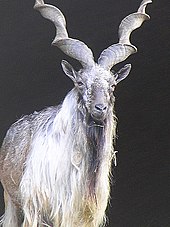
Markhor, Pakistan’s national animal
In the north, a wide variety of animals have found home in the mountainous regions including the Marco Polo sheep, Urial sheep, Markhor and Ibex goats, black and brown Himalayan bears, and the rare Snow Leopard. Another rare species is the blind Indus River Dolphin of which there are believed to be about 1,100 remaining, protected at the Indus River Dolphin Reserve in Sindh.[78] There have been sightings of the rare Asiatic cheetahs in the southwestern deserts of Sindh and Balochistan.
Apart from crows, sparrows and myna, hawks, falcons, and eagles are the more commonly found birds in Pakistan. A lot of birds sighted within Pakistan are migratory as they make their way from Europe, Central Asia and India.[79]
In recent years, the number of wild animals being killed for fur and leather trading led to a new law banning the hunting of wild animals and birds as well as the establishment of several wildlife sanctuaries and game reserves. The number of hunters have greatly dwindled since then.[80]
Vast sections of the Indus flood plains have been cleared of natural vegetation to grow crops. Only animals like the jackal, mongoose, jungle cat, civet cat, scaly anteater, desert cat and the wild hare occur in these areas. Hog deer are found in riveine tracts. The crop residues and wild growth support reasonable populations of black and grey partridges.[81]
The lack of vegetative cover, severity of climatic conditions, and the impact of grazing animals on the deserts have left wild animals in a precarious position. Chinkara is the only animal that can still be found in significant numbers in Cholistan.[82] The blackbuck, once plentiful in Cholistan, has now been eliminated; efforts are being made to reintroduce them into the country. A small number of blue bulls are found along the Pakistan-Indian border, and in some parts of Cholistan. Grey partridge, species of sand grouseand the Indian courser are the main birds of the area. Peafowl occur in some areas in Cholistan.[83]
Economy
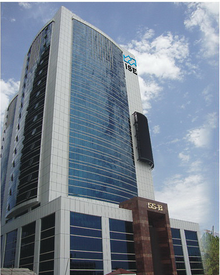
Islamabad Stock Exchange Tower located in the Blue Area.
Pakistan has a semi-industrialized economy.[84][85] The growth poles of the Pakistani economy are situated along the Indus River.[85][86] Diversified economies of Karachi and Punjab’s urban centres, coexist with lesser developed areas in other parts of the country.[85] Despite being a very poor country in 1947, Pakistan’s economic growth rate has been better than the global average during the subsequent four decades, but imprudent policies led to a slowdown in the late 1990s.[87]
Recently, wide-ranging economic reforms have resulted in a stronger economic outlook and accelerated growth especially in the manufacturing and financial services sectors.[87] Since the 1990s, there has been great improvement in the foreign exchange position and rapid growth in hard currency reserves.[87]
The 2005 estimate of foreign debt was close to US$40 billion. However, this has decreased in recent years with assistance from the International Monetary Fund and significant debt-relief from the United States. Pakistan’s gross domestic product, as measured by purchasing power parity, is estimated to be $475.4 billion[88] while its per capita income stands at $2,942.[88] The poverty rate in Pakistan is estimated to be between 23%[89] and 28%.[90]
GDP growth was steady during the mid-2000s at a rate of 7%;[91][92] however, slowed down during the Economic crisis of 2008 to 4.7%.[21] A large inflation rate of 24.4% and a low savings rate, and other economic factors, continue to make it difficult to sustain a high growth rate.[93][94] Pakistan’s GDP is US$167 billions, which makes it the 48th-largest economy in the world or 27th largest by purchasing power adjusted exchange rates. Today, Pakistan is regarded as to having the second largest economy in South Asia.[95]
The structure of the Pakistani economy has changed from a mainly agricultural base to a strong service base. Agriculture now only accounts for roughly 20% of the GDP, while the service sector accounts for 53% of the GDP.[96] Significant foreign investments have been made in several areas including telecommunications, real estate and energy.[97][98] Other important industries include apparel and textiles (accounting for nearly 60% of exports), food processing, chemicals manufacture, and the iron and steel industries.[99] Pakistan’s exports in 2008 amounted to $20.62 billion (USD).[21] Pakistan is a rapidly developing country.[100][101][102]
However, the economic crisis of 2008 led Pakistan to seek more than $100 billion in aid in order to avoid possible bankruptcy.[103][104] This was never given to Pakistan and it had to depend on a more aggressive fiscal policy, backed by the IMF. A year later, Asian Development Bank reported that the Pakistan economic crisis was easing.[105] Furthermore it is projected that in 2010 Pakistan economy would grow at least 4% and could grow more with strong international economic recovery.[106]
Demographics
The estimated population of Pakistan in 2010 was over 170 million[2] making it the world’s sixth most-populous country, behind Brazil and ahead of Bangladesh. In 1951 Pakistan had a population of 34 million.[107] The population growth rate now stands at 1.6%.[108] The majority of southern Pakistan’s population live along the Indus River. By population size, Karachi is the largest city of Pakistan.[109] In the northern half, most of the population live in an arc formed by the cities of Lahore, Faisalabad, Rawalpindi, Islamabad, Gujranwala, Sialkot, Gujrat, Jhelum, Sargodha, Sheikhupura, Nowshera, Mardan and Peshawar. About 20% of the population live below the international poverty line of US$1.25 a day .[110]
Life expectancy at birth is 63 years for females and 62 years for males as of 2006[111] compared to the healthy life expectancy at birth which was 54 years for males and 52 years for females in 2003.[111] Expenditure on health was at 2% of the GDP in 2006.[111] The mortality below 5 was at 97 per 1,000 live births in 2006.[111] During 1990–2003, Pakistan sustained its historical lead as the most urbanised nation in South Asia, with city dwellers making up 36% of its population.[112] Furthermore, 50% of Pakistanis now reside in towns of 5,000 people or more.[113]
Pakistan is a multilingual country with more than sixty languages being spoken. English is the official language of Pakistan and used in official business, government, and legal contracts,[21] and Punjabi has a plurality of native speakers, Urdu is the lingua franca and national language in Pakistan. Punjabi is the provincial language of Punjab. Saraiki is also spoken in the larger area of Punjab province. Pashto is the provincial language of Khyber Pakhtunkhwa. Sindhi is the provincial language of Sindh and Balochi is the provincial language of Balochistan.[114]
Pakistan is the second-most populous Muslim-majority country[12][115] and also has the second-largest Shi’a population in the world.[116] About 97% of the Pakistanis are Muslim. The majority are Sunni, with an estimated 5-20% Shi’a.[117][118][119][120][121] 2.3% are Ahmadis,[122] who are officially considered non-Muslims since a 1974 "anti-Ahmadi” constitutional amendment.[123] There are also several Sufi and Quraniyoon communities.[124][125][126][127] Although the groups of Muslims usually coexist peacefully, sectarian violence occurs sporadically.[128] The religious breakdown of the country is as follows:[117][118][119][120][121]
- Islam 173,000,000 (97%) (the majority are Sunni Muslims, 5-20% are Shi’a and 2.3% are Ahmadis).
- Hinduism 2,800,000 (1.6%)[117]
- Christianity 2,800,000 (1.6%)[117]
- Sikhs Around 20,000 (0.001%)
- The remaining are Parsis, Buddhists, Jews, Bahá’ís, and Animists (mainly the Kalasha of Chitral).[129]
The population comprises several main ethnic groups (2009)[130]:
- Punjabis (44.15%) 78.7 million
- Pashtuns (15.42%) 27.2 million
- Sindhis (14.1%) 24.8 million
- Seraikis (10.53%) 14.8 million
- Muhajirs (7.57%) 13.3 million
- Balochs is (3.57%) 6.3 million
- Others (4.66%) 11.1 million
Smaller ethnic groups, such as Kashmiris, Hindkowans, Kalash, Burusho, Brahui, Khowar,Ranghar, Meo, Shina, and Turwalis are mainly found in the northern parts of the country.
Pakistan’s census does not include the registered 1.7 million Afghan refugees from neighbouring Afghanistan, who are mainly found in the Khyber Pakhtunkhwa and Federally Administered Tribal Areas (FATA) areas, with small numbers in the cities of Karachi and Quetta.[131] Around 2 million refugees from Bangladesh, Iran, Africa, and other places are also found in Pakistan.
| view · talk · edit view · talk · edit Largest cities of Pakistan 2010 estimate[132] |
|||||||||||
|---|---|---|---|---|---|---|---|---|---|---|---|
 Karachi  Lahore |
|||||||||||
| Rank | City Name | Province | Pop. | Rank | City Name | Province | Pop. |  Faisalabad  Rawalpindi |
|||
| 1 | Karachi | Sindh | 13,205,339 | 11 | Sargodha | Punjab | 600,501 | ||||
| 2 | Lahore | Punjab | 7,129,609 | 12 | Bahawalpur | Punjab | 543,929 | ||||
| 3 | Faisalabad | Punjab | 2,880,675 | 13 | Sialkot | Punjab | 510,863 | ||||
| 4 | Rawalpindi | Punjab | 1,991,656 | 14 | Sukkur | Sindh | 493,438 | ||||
| 5 | Multan | Punjab | 1,606,481 | 15 | Larkana | Sindh | 456,544 | ||||
| 6 | Hyderabad | Sindh | 1,578,367 | 16 | Sheikhupura | Punjab | 426,980 | ||||
| 7 | Gujranwala | Punjab | 1,569,090 | 17 | Jhang | Punjab | 372,645 | ||||
| 8 | Peshawar | KP | 1,439,205 | 18 | Rahim Yar Khan | Punjab | 353,112 | ||||
| 9 | Quetta | Balochistan | 896,090 | 19 | Mardan | KP | 352,135 | ||||
| 10 | Islamabad | Capital Territory | 689,249 | 20 | Gujrat | Punjab | 336,727 | ||||
Education
According to the constitution of Pakistan, it is the state’s responsibility to provide free primary education.[133] At the time of independence Pakistan had only one university, the University of the Punjab, founded in 1882 in Lahore. Pakistan now has more than 132 universities of which 73 are public universities and 59 are private universities.[134] [135]
Education in Pakistan is divided into five levels: primary (grades one through five); middle (grades six through eight); high (grades nine and ten, leading to the Secondary School Certificate); intermediate (grades eleven and twelve, leading to a Higher Secondary School Certificate); and university programmes leading to graduate and advanced degrees.[136]
Pakistan also has a parallel secondary school education system in private schools, which is based upon the curriculum set and administered by the Cambridge International Examinations, in place of government exams. Some students choose to take the O level and A level[137] exams through the British Council.
There are currently 730 technical & vocational institutions in Pakistan.[138] The minimum qualifications to enter male vocational institutions, is the completion of grade 8, and for female is grade 5.
English medium education is to be extended, on a phased basis, to all schools across the country.[139] Through various educational reforms, by the year 2015, the ministry of education expects to attain 100% enrolment levels amongst primary school aged children, and a literacy rate of 86% amongst people aged over 10.[140]
Pakistan also has madrassahs that provide free Islamic education and also offer free boarding and lodging to students who come mainly from the poorer strata of society.[141] After criticism over terrorists using them for recruiting purposes, efforts have been made to regulate them.[142]
In 2004 only 46.6 percent of adult Pakistanis were literate. Male literacy was 60.6 percent, while female literacy was 31.5 percent. Literacy rates also vary regionally, and particularly by sex, for instance in tribal areas female literacy is 3%.[143] The government launched a nationwide initiative in 1998 with the aim of eradicating illiteracy and providing a basic education to all children.[144]
Culture
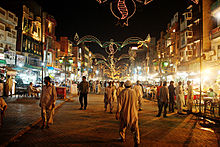
View of Food Street in Lahore
Pakistani society is largely hierarchical, with high regard for traditional Islamic values, although urban families have grown into a nuclear family system because of the socio-economic constraints imposed by the traditional joint family system.[145] Recent decades have seen the emergence of a middle class in cities like Karachi, Lahore, Islamabad, Rawalpindi, Hyderabad, Faisalabad, Multan and Peshawar (now numbering at 30 million, with an average annual income of US$10,000, with another 17 million belonging to the upper and upper-middle classes[146] that wish to move in a more centrist direction, as opposed to the northwestern regions bordering Afghanistan that remain highly conservative and dominated by centuries-old regional tribal customs. Increasing globalisation has resulted in ranking 46th on the A.T. Kearney/FP Globalization Index.[147]
The variety of Pakistani music ranges from diverse provincial folk music and traditional styles such as Qawwali and Ghazal Gayaki to modern forms fusing traditional and western music, such as the synchronisation of Qawwali and western music by the world renowned Nusrat Fateh Ali Khan. In addition Pakistan is home to many famous folk singers such as the late Alam Lohar, who is also well known in Indian Punjab. However, majority of Pakistanis listen to Indian music produced by Bollywood and other Indian film industries. The arrival of Afghan refugees in the western provinces has rekindled Pashto and Persian music and established Peshawar as a hub for Afghan musicians and a distribution center for Afghan music abroad.[148]
State-owned Pakistan Television Corporation (PTV) and Pakistan Broadcasting Corporation were the dominant media outlets, but there are now numerous private television channels. Various American, European, and Asian television channels and films are available to the majority of the Pakistani population via private television networks, cable, and satellite television (43 million Pakistanis have satellite television).[149] There are also small indigenous film industries based in Lahore and Peshawar (often referred to as Lollywood). And while Bollywood films have been banned from being played in public cinemas since 1965 they have remained in popular culture.[150]
The architecture of the areas now constituting Pakistan can be designated to four distinct periods—pre-Islamic, Islamic, colonial and post-colonial. With the beginning of the Indus civilisation around the middle of the 3rd millennium B.C.,[151] an advanced urban culture developed for the first time in the region, with large structural facilities, some of which survive to this day.[152] Mohenjo Daro, Harappa and Kot Diji belong to the pre-Islamic era settlements. The rise of Buddhism and the Persian and Greek influence led to the development of the Greco-Buddhist style, starting from the 1st century CE. The high point of this era was reached with the culmination of the Gandhara style.

Sir Muhammad Iqbal was a key leader in the Pakistan Movement. He is also a national poet of Pakistan.
An example of Buddhist architecture is the ruins of the Buddhist monastery Takht-i-Bahi in the northwest province.[153]
The arrival of Islam in today’s Pakistan meant a sudden end of Buddhist architecture.[154] However, a smooth transition to predominantly pictureless Islamic architecture occurred. The most important of the few completely discovered buildings of Persian style is the tomb of the Shah Rukn-i-Alam in Multan. During the Mughal era design elements of Islamic-Persian architecture were fused with and often produced playful forms of the Hindustani art. Lahore, occasional residence of Mughal rulers, exhibits a multiplicity of important buildings from the empire, among them the Badshahi mosque, the fortress of Lahore with the famous Alamgiri Gate, the colourful, still strongly Persian seeming Wazir Khan Mosque as well as numerous other mosques and mausoleums. Also the Shahjahan Mosque of Thatta in Sindh originates from the epoch of the Mughals. In the British colonial period, predominantly functional buildings of the Indo-European representative style developed from a mixture of European and Indian-Islamic components. Post-colonial national identity is expressed in modern structures like the Faisal Mosque, the Minar-e-Pakistan and the Mazar-e-Quaid.[155]
The literature of Pakistan covers the literatures of languages spread throughout the country, namely Urdu, Sindhi, Punjabi, Pushto, Baluchi as well as English[156] and Persian as well. Prior to the 19th century, the literature mainly consisted of lyric poetry and religious, mystical and popular materials. During the colonial age the native literary figures, under the influence of the western literature of realism, took up increasingly different topics and telling forms. Today, short stories enjoy a special popularity.[157]
The national poet of Pakistan, Allama Muhammad Iqbal, suggested the creation of a separate homeland for the Muslims of India. However, Iqbal had also wrote the Tarana-e-Hind which stated the belief of a strong united India. His book The Reconstruction of Religious Thought in Islam is a major work of modern Islamic philosophy. The most well-known representative of the contemporary Urdu literature of Pakistan is Faiz Ahmed Faiz. Sufi poets Shah Abdul Latif, Bulleh Shah, Mian Muhammad Bakhsh and Khawaja Farid are also very popular in Pakistan.[158] Mirza Kalich Beg has been termed the father of modern Sindhi prose.[159]
Tourism

The Deosai National Park is located in Skardu, Gilgit-Baltistan, Pakistan.
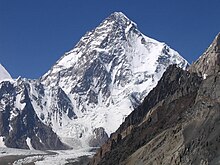
K2 is the second-highest mountain on Earth after Mount Everest. With a peak elevation of 8,611 metres (28,251 ft), K2 is part of the Karakoram range, Pakistan.
Despite being once listed as one of the most dangerous countries in the world by The Economist,[160] tourism is still a growing industry in Pakistan because of its diverse cultures, peoples and landscapes.[161] The variety of attractions ranges from the ruins of ancient civilisations such as Mohenjo-daro, Harappa and Taxila, to the Himalayan hill-stations, that attract those interested in field and winter sports. Pakistan also has five out of fourteen mountain peaks of height over 8,000 metres (26,250 ft), that attract adventurers and mountaineers from around the world, especially to K2.[162] From April to September, domestic and international visitors to these areas bring tourist income to the local people.

Utror Swat valley May-2010
In Balochistan there are many caves for cavers and tourists to visit especially the Juniper Shaft Cave, the Murghagull Gharra cave, Mughall saa cave, and Pakistan’s naturally decorated cave, the Mangocher Cave. Pakistan is a member country of the Union International de Spéléologie (UIS).[163]
The northern parts of Pakistan are home to several historical fortresses, towers and other architecture including the Hunza and Chitral valleys, the latter being home to the Kalash, a small pre-Islamic Animist community.[164] Punjab is also the site of Alexander’s battle on the Jhelum River. The historic city of Lahore is considered Pakistan’s cultural centre and has many examples of Mughal architecture such as the Badshahi Masjid, Shalimar Gardens, Tomb of Jahangir and the Lahore Fort.[165] The Pakistan Tourism Development Corporation (PTDC) also helps promote tourism in the country.[166] However, tourism is still limited because of the lack of proper infrastructure and the worsening security situation in the country. The recent militancy in Pakistan’s scenic sites, including Swat in Khybar Pakhtoon Kawa province, have dealt a massive blow to the tourism industry. Many of the troubles in these tourist destinations are also blamed on the frail travel network, tourism regulatory framework, low prioritisation of the tourism industry by the government, low effectiveness of marketing and a constricted tourism perception.[167][168] After these areas were being cleared off the militant groups in late 2009, the government, with financial support from the USAID, started a campaign to reintroduce tourism in Swat valley. Pakistan receives 500,000 tourists annually, with almost half of them heading to northern Pakistan.[169]
Sports
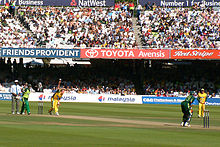
Cricket is the most popular sport in Pakistan
The national sport of Pakistan is field hockey, although cricket is the most popular game across the country.[170] The national cricket team has won the Cricket World Cup once (in 1992), were runners-up once (in 1999), and co-hosted the games twice (in 1987 and 1996). Pakistan were runners-up in the inaugural 2007 ICC World Twenty20 held in South Africa and were the champions at the 2009 ICC World Twenty20 held in England. Lately however, Pakistani cricket has suffered heavily due to teams refusing to tour Pakistan because of terrorism fears. No teams have toured Pakistan since March 2009, when militants attacked the touring Sri Lankan cricket players.[171]
Squash is another sport that Pakistanis have excelled in. Successful world-class squash players such as Jahangir Khan and Jansher Khan have won the World Open several times during their careers.
At international level, Pakistan has competed many times at the Olympics in field hockey, boxing, athletics, swimming, and shooting. Pakistan’s Olympic medal tally stands at 10 (3 gold, 3 silver and 4 bronze) while the Commonwealth Games and Asian Games medal tally stands at 61 and 182 respectively. Hockey is the sport in which Pakistan has been most successful at the Olympics, with three gold medals in (1960, 1968, and 1984). Pakistan has also won the Hockey World Cup a record four times (1971, 1978, 1982, 1994).
Among others, Association football and Polo are the more prominent sports with regular national events held in different parts of the country. Boxing, Billiards, Snooker, Rowing, Kayaking, Caving, Tennis, Contract Bridge, Golf and Volley Ball are also actively participated and Pakistan has produced notable champions in these sports at regional and international levels.
Transport

The Makran Coastal Highway starts from Karachi and goes all the way to Gwadar.
Rail services in Pakistan are provided by the state-run Pakistan Railways, under the supervision of the Ministry of Railways. Pakistan Railways provides an important mode of transportation in Pakistan, catering to the large-scale movement of people and freight. The railway network comprises 8,163 km[172] of which 1,676 mm (5 ft 6 in) (broad gauge) forms 7,718 km including 293 km of electrified track. Pakistan Railways carry 65 million passengers annually and daily operates 228 mail, express and passenger trains. Pakistan Railways also operate special trains for various occasions. The Freight Business Unit with 12000 personnel operates over 200 freight stations on the railway network. Pakistan has also planned or had many Mass Transit Systems. The Karachi Circular Railway, which opened in the early 1940s, is the only functioning Mass Transit System in Pakistan as of date. In 1976, Karachi was slated to begin work on an underground metro system, but plans have been put on hold since. The Lahore Metro is another proposal still in planning and is scheduled to be completed by 2020. Pakistan has been successful in foreign trade by rail. Pakistan has successfully traded with countries such as Turkey, Iran, Afghanistan, India, Turkmenistan and China.[173]
During the 1990s, Pakistan began an ongoing project to rebuild all national highways throughout the country specifically to important financial, cargo and textile centres. The National Highway Authority or NHA is responsible for the maintenance of all national highways in Pakistan. The construction of motorways began in the early 1990s with the idea building a world class road network and to reduce the load off the heavily used national highways throughout the country. The first motorway to be completed was M1 in 1997 from Peshawar to Islamabad. Later on, highways such as M2 from Islamabad to Lahore, M3 from Pindi Bhattian to Faisalabad, M9 from Hyderabad to Karachi, Karachi Northern Bypass from Hyderabad to Karachi, and the Lahore Ring Road[174] were completed.
The waterway network in Pakistan is in its infancy with Karachi being the only major city situated next to the Arabian Sea. Plans are being proposed for the development of the waterways in the country along the Indus River and through the Punjab as it would boost employment opportunities and the economic and social development in Pakistan.[175] Pakistan has an estimated 139 airports, 10 of them international.[176]
See also
|
|||||||||||||||||||||||||||||||||||||||||||||||||||||||||||||||||||||||||||||||||||||||||||||||||||||||||||||||||
References
- ^ "Population by Mother Tongue”. Population Census Organization of Pakistan. http://www.statpak.gov.pk/depts/pco/statistics/other_tables/pop_by_mother_tongue.pdf. Retrieved 22 September 2010.
- ^ a b c "Official Pakistani Population clock”. Ministry of Economic Affairs and Statistics. http://www.statpak.gov.pk/depts/pco/. Retrieved 17 January 2010.
- ^ "Area, Population, Density and Urban/Rural Proportion by Administrative Units”. Population Census Organization, Government of Pakistan. http://www.statpak.gov.pk/depts/pco/statistics/area_pop/area_pop.html. Retrieved 13 February 2008.
- ^ a b c d "Pakistan”. International Monetary Fund. http://www.imf.org/external/pubs/ft/weo/2010/01/weodata/weorept.aspx?sy=2007&ey=2010&scsm=1&ssd=1&sort=country&ds=.&br=1&c=564&s=NGDPD%2CNGDPDPC%2CPPPGDP%2CPPPPC%2CLP&grp=0&a=&pr.x=43&pr.y=19. Retrieved 21 April 2010.
- ^ "Human Development Report 2010. Human development index trends: Table 1”. The United Nations. http://hdr.undp.org/en/media/HDR_2010_EN_Complete.pdf. Retrieved 25 January 2011.
- ^ Loureiro, Miguel (28 July 2005). "Driving—the good, the bad and the ugly”. Daily Times (Pakistan). http://www.dailytimes.com.pk/default.asp?page=story_28-7-2005_pg3_5. Retrieved 10 January 2010.
- ^ The Kashmir region is claimed by Pakistan and India. Pakistan refers to Indian-administered Kashmir as Indian occupied Kashmir.
- ^ Yasmeen (2007), p.3.
- ^ Zabeeh, Zia-ur-Rahman. "Pakistan Movement”. Cyber City Online. http://www.cybercity-online.net/pof/pakistan_movement.html. Retrieved 8 July 2010.
- ^ "29 February 1956 – Pakistan becomes a republic”. http://sify.com.+29 February 2008. http://sify.com/news/feb-29-1956-pakistan-becomes-a-republic-news-national-jegmOWbafac.html. Retrieved 8 July 2010.
- ^ "Bangladesh Liberation War 1971”. http://meltingpot.fortunecity.com: Ananda Publishers. 1990. http://meltingpot.fortunecity.com/hastings/430/. Retrieved 8 July 2010. [dead link]
- ^ a b "Muslim Population—Statistics About the Muslim Population of the World”. About.com. http://islam.about.com/od/muslimcountries/a/population.htm. Retrieved 27 July 2009.
- ^ "WIKILEAKS SHOW US MICRO-MANAGING PAKISTAN”. South Asia Analysis Group. 05.12. 2010. http://www.southasiaanalysis.org/%5Cpapers43%5Cpaper4205.html. Retrieved 13.03.2011.
- ^ Kapila, Dr. Subhash (22. 03. 2004). "United States Designates Pakistan as Major non-NATO ally of American in South Asia: An Analysis”. South Asia Analysis Group. http://www.southasiaanalysis.org/papers10/paper959.html. Retrieved 8 July 2010.
- ^ "Senate OIC Report”. Senate of Pakistan: Senate Foreign Relations Committee. September 2005. p. 17. http://webcache.googleusercontent.com/search?q=cache:QWX4xqdo4jcJ:www.foreignaffairscommittee.org/includes/content_files/PAKISTANANDTHEOIC.pdf+pakistan+founding+member+of+oic&cd=4&hl=en&ct=clnk&gl=my. Retrieved 8 July 2010.
- ^ "United Nations Member States”. http://www.un.org/en/members/index.shtml: United Nations. 3 July 2006. http://www.un.org/en/members/index.shtml#p. Retrieved 8 July 2010.
- ^ "Pakistan”. Commonwealth Secretariat. http://www.thecommonwealth.org/YearbookHomeInternal/138945/. Retrieved 8 July 2010.
- ^ Choudhary Rahmat Ali (28 January 1933). "Now or never: Are we to live or perish for ever?”. Columbia University. http://www.columbia.edu/itc/mealac/pritchett/00islamlinks/txt_rahmatali_1933.html. Retrieved 4 December 2007.
- ^ [1][dead link], Rahmat Ali :: Now or Never
- ^ Meghan A Porter. "Minnesota State University page on Mohenjo-Daro”. http://www.mnsu.edu/emuseum/archaeology/sites/middle_east/mohenjo_daro.html. Retrieved 15 January 2010.
- ^ a b c d e f "Pakistan”. World Factbook. CIA. https://www.cia.gov/library/publications/the-world-factbook/geos/pk.html. Retrieved 13 February 2008.
- ^ Jona Lendering. "Maurya dynasty”. http://www.livius.org/man-md/mauryas/mauryas.html. Retrieved 17 June 2007.
- ^ Spear (2007), p.46.
- ^ M.H. Panhwar. "International trade of Sindh From its port Barbaricon (Banbhore) (200 BC to 200 AD)”. http://www.panhwar.com/Article60.htm. Retrieved 15 January 2010.
- ^ Jona Lendering. "Achaemenids”. http://www.livius.org/aa-ac/achaemenians/achaemenians.html. Retrieved 12 March 2009.
- ^ "Plutarch’s Life of Alexander". http://penelope.uchicago.edu/Thayer/E/Roman/Texts/Plutarch/Lives/Alexander*/8.html#ref98. Retrieved 12 March 2009.
- ^ Professor Dr. Ahmad Hasan Dani. "Guide to Historic Taxila”. http://www.heritage.gov.pk/html_Pages/guide_to_historic_taxila.htm. Retrieved 15 January 2010.
- ^ Wink (1996), p.152.
- ^ "Infinity Foundation’s translation of the Chach-Nama”. http://www.infinityfoundation.com/ECITChachnamaframeset.htm. Retrieved 12 March 2009.
- ^ "History in Chronological Order”. Government of Pakistan. http://www.infopak.gov.pk/History.aspx. Retrieved 15 January 2010.
- ^ "A Country Study: Pakistan”. Library of Congress. http://lcweb2.loc.gov/frd/cs/pktoc.html. Retrieved 12 March 2009.
- ^ Farndon (1999), p.455.
- ^ "Sir Muhammad Iqbal’s 1930 Presidential Address”. Speeches, Writings, and Statements of Iqbal. http://www.columbia.edu/itc/mealac/pritchett/00islamlinks/txt_iqbal_1930.html. Retrieved 19 December 2006.
- ^ "The Birth of Pakistan [August 14, 1947"]. http://www.storyofpakistan.com/articletext.asp?artid=A050. Retrieved 19 January 2010.
- ^ W. D. Rubinstein (2004), p. 270.
- ^ "Resolution adopted by the United Nations Commission for India and Pakistan”. http://www.mtholyoke.edu/acad/intrel/uncom1.htm. Retrieved 19 January 2010.
- ^ "1971 war summary”. BBC. 2002. http://news.bbc.co.uk/hi/english/static/in_depth/south_asia/2002/india_pakistan/timeline/1971.stm. Retrieved 16 March 2009.
- ^ "US Country Studies article on the Bangladesh War”. U.S. Library of Congress. http://countrystudies.us/bangladesh/17.htm. Retrieved 16 March 2009.
- ^ "The 1991 Gulf war”. San Francisco Chronicle. 24 September 2002. http://www.sfgate.com/cgi-bin/article.cgi?f=/c/a/2002/09/24/MN168392.DTL. Retrieved 16 March 2009.
- ^ "India launches Kashmir air attack”. BBC News. 26 May 1999. http://news.bbc.co.uk/1/hi/world/south_asia/352995.stm. Retrieved 5 August 2008.
- ^ "Pakistan after the coup: Special report”. BBC. 12 October 2000. http://news.bbc.co.uk/2/hi/south_asia/472968.stm. Retrieved 17 March 2009.
- ^ "New Pakistan PM Gillani sworn in”. BBC. 25 March 2008. http://news.bbc.co.uk/1/hi/world/south_asia/7312116.stm. Retrieved 17 March 2009.
- ^ Candace Rondeaux (19 August 2008). "Musharraf Exits, but Uncertainty Remains”. The Washington Post. http://www.cnn.com/2008/WORLD/asiapcf/08/18/musharraf.address/. Retrieved 19 January 2010.
- ^ United Press International.. "3.4 million displaced by Pakistan fighting”. http://www.upi.com/Top_News/2009/05/30/34-million-displaced-by-Pakistan-fighting/UPI-68801243704876/. Retrieved 24 July 2010.
- ^ a b c d e "Government of Pakistan”. http://www.pakistans.com/pakistan/government. Retrieved 16 March 2009.
- ^ "World: South Asia Pakistan’s army and its history of politics”. BBC. 10 December 1999. http://news.bbc.co.uk/1/hi/world/south_asia/472953.stm. Retrieved 16 March 2009.
- ^ M. Zafar. "How Pakistan Army moved into the Political Arena”. http://www.defencejournal.com/2001/september/arena.htm. Retrieved 15 March 2009.
- ^ Balochis of Pakistan: On the Margins of History. United Kingdom: Foreign Policy Centre. 2006. p. 75. ISBN 978-1-905833-08-5.
- ^ Robert Nolan. "Pakistan: The Most Allied Ally in Asia”. http://www.fpa.org/newsletter_info2583/newsletter_info_sub_list.htm?section=Pakistan%3A%20The%20Most%20Allied%20Ally%20in%20Asia. Retrieved 12 March 2009.
- ^ "National Symbols of Pakistan”. Ministry of Culture, Government of Pakistan. http://202.83.164.26/wps/portal/Mocul/!ut/p/c0/04_SB8K8xLLM9MSSzPy8xBz9CP0os3h_Nx9_SzcPIwP_IB8DA6MQN6MgP39LQ09_U_2CbEdFAGG3mnQ!/?WCM_PORTLET=PC_7_OFLO9FH20ORL002TF2RNO91IV4_WCM&WCM_GLOBAL_CONTEXT=/wps/wcm/connect/moculcl/sCultureOfPakistan/SaNationalsymbolsofPakistan/. Retrieved 2009-02-07.
- ^ Dr. Nazir Khaja. "Pakistan & USA – Allies in the war on Terrorism!”. http://www.defencetalk.com/pakistan-usa-allies-in-the-war-on-terrorism-1865/. Retrieved 15 February 2010.
- ^ "Why America Should Be A Trustworthy Friend of Pakistan”. http://www.pakistanview.com. Retrieved 16 March 2009.
- ^ Sabir Shah. "US military aid to Pakistan suspended six times since 1954.”. The News International, Pakistan. http://www.thenews.com.pk/daily_detail.asp?id=205102. Retrieved 26 October 2009. [dead link]
- ^ Alain Gresh. "The United States’ new backyard”. http://mondediplo.com/2007/11/03mideast. Retrieved 24 July 2010.
- ^ Ahmed Rashid (10 January 2007). "Pakistan’s uncertain year ahead”. BBC News. http://news.bbc.co.uk/2/hi/south_asia/6211639.stm?lsf. Retrieved 2 April 2008.
- ^ "Syed Yousuf Raza Gillani the New Prime minister Appointed by PPP”. www.BuzzVines.com. http://www.buzzvines.com/syed-yousuf-raza-gillani-new-prime-minister-appointed-ppp. Retrieved 15 April 2009.
- ^ Associated Press (18 August 2008). "Pakistani President Musharraf Resigns Amid Impeachment Threats”. Fox News. http://www.foxnews.com/story/0,2933,405221,00.html. Retrieved 18 August 2008.
- ^ "Zardari wins Pakistan presidential election: officials”. AFP. 5 September 2008. http://afp.google.com/article/ALeqM5i9dz2ZxX6MRv5ZOKT4cx4-1O_qTQ. Retrieved 17 March 2009.
- ^ "What is Decentralization Support Program”. Decentralization Support Program, Government of Pakistan. http://www.decentralization.org.pk/whatisdsp.asp. Retrieved 8 February 2008.
- ^ Fata.gov.pk, map of Agencies and Regions in FATA
- ^ "Azad Jammu and Kashmir Districts”. http://www.ajk.gov.pk/index.php?option=com_content&view=article&id=42&Itemid=12. . Districts, Govt. of AJK
- ^ Dunyanews.tv, Gilgit-Baltistan Empowerment and Self Governance Order 2009
- ^ Declan Walsh (31 May 2007). "Book shines light on Pakistan military’s ‘£10bn empire'”. The Guardian (London). http://www.guardian.co.uk/world/2007/may/31/books.pakistan. Retrieved 31 May 2007.
- ^ "Pakistan Armed Forces”. Center For Defense Information. http://www.cdi.org/issues/Asia/PAKISTAN.html. Retrieved 24 July 2010.
- ^ "Child Soldiers Global Report 2008 – Pakistan”. UNHCR. 20 May 2008. http://www.unhcr.org/refworld/country,,CSCOAL,,PAK,,486cb123c,0.html. Retrieved 9 October 2010.
- ^ Ian (1999), p.99.
- ^ "Pakistan Armed Forces”. Scramble Magazine. http://www.scramble.nl/pk.htm. Retrieved 24 July 2010.
- ^ "Pakistani Public Opinion”. Pew Research Center. 13 August 2009. http://pewglobal.org/2009/08/13/pakistani-public-opinion/. Retrieved 8 July 2010.
- ^ Declan Walsh (11 January 2010). "Pakistan suffers record number of deaths due to militant violence”. The Guardian (London). http://www.guardian.co.uk/world/2010/jan/11/pakistan-militant-violence-death-toll. Retrieved 11 January 2010.
- ^ "Monthly Summary of Contributors to UN Peacekeeping Operations” (PDF). United Nations. http://www.un.org/en/peacekeeping/contributors/2009/dec09_1.pdf. Retrieved 18 January 2010.
- ^ "Pakistan Army”. Pakistan Defense. http://www.defence.pk/pakistan-army/. Retrieved 11 March 2009.
- ^ "About Pakistan: Geography”. American Institute For Pakistan Studies. http://www.pakistanstudies-aips.org/pakistan/geography/index.html. Retrieved 24 July 2010.
- ^ InfoPlease. "Pakistan”. http://www.infoplease.com/ipa/A0107861.html. Retrieved 16 March 2009.
- ^ U.S. Library of Congress. "Climate”. http://countrystudies.us/pakistan/25.htm. Retrieved 16 March 2009.
- ^ "Pakistan Climate”. Encyclopedia of the Nations. 28 March 2008. http://www.nationsencyclopedia.com/Asia-and-Oceania/Pakistan-CLIMATE.html. Retrieved 16 March 2009.
- ^ "Conservation of Mangrove Forests in the Coastal Areas of Sindh and Balochistan”. WWF Pakistan. http://www.wwfpak.org/forest_mangrove.php. Retrieved 17 March 2009.
- ^ "Pakistan Deforestation Rates and Related Forestry Figures”. Mongabay.com. http://rainforests.mongabay.com/deforestation/2000/Pakistan.htm.
- ^ Paul Massicot (21 June 2006). "Animal Info:Indus River Dolphin”. http://www.animalinfo.org/species/cetacean/platmino.htm. Retrieved 17 March 2009.
- ^ "International Visitors: Birds Come Flying In”. http://pakistaniat.com/2006/11/29/pakistan-birds/.
- ^ "Pakistan Wildlife”. Wildlife Sanctuaries of Pakistan. http://www.wildlifeofpakistan.com/wildlifesanctuarygamereservesmap.htm. Retrieved 12 March 2009.
- ^ Wildlife of Pakistan. "Mammals of Pakistan”. http://www.wildlifeofpakistan.com/MammalsofPakistan/mammalsofPakistanmain.htm. Retrieved 24 July 2010.
- ^ Wildlife of Pakistan. "Existing Wildlife in Pakistan”. http://www.wildlifeofpakistan.com/WildlifeBiodiversityofPakistan/existingwildlifeinPakistan.htm. Retrieved 24 July 2010.
- ^ Indus Asia Online Journal. "Sindh’s wildlife in danger”. http://iaoj.wordpress.com/2009/01/25/sindhs-wildlife-in-danger/. Retrieved 24 July 2010.
- ^ "Agricultural Economics : An analysis of industrial–agricultural interactions: a case study in Pakistan”. ScienceDirect. http://www.sciencedirect.com/science?_ob=ArticleURL&_udi=B6T3V-3Y21V48-F&_user=10&_rdoc=1&_fmt=&_orig=search&_sort=d&_docanchor=&view=c&_acct=C000050221&_version=1&_urlVersion=0&_userid=10&md5=2d4b7d3ce3b0b4005140c271bb7312a7. Retrieved 2 January 2010.
- ^ a b c "World Bank Document” (PDF). http://siteresources.worldbank.org/PAKISTANEXTN/Resources/293051-1241610364594/6097548-1257441952102/balochistaneconomicreportvol2.pdf. Retrieved 2 January 2010.
- ^ "Pakistan”. Gecon.yale.edu. http://gecon.yale.edu/Pakistan.htm. Retrieved 2 January 2010. [dead link]
- ^ a b c "Economy”. Pakistan Trade Development Authority. http://www.epb.gov.pk/v1/travelguide/. Retrieved 8 March 2009.
- ^ a b "Report for Selected Countries and Subjects (PPP)”. International Monetary Fund. http://www.imf.org/external/pubs/ft/weo/2007/02/weodata/weorept.aspx?sy=2007&ey=2007&scsm=1&ssd=1&sort=country&ds=.&br=1&c=564&s=PPPGDP%2CPPPPC&grp=0&a=&pr.x=59&pr.y=1. Retrieved 8 October 2007.
- ^ "WB, UNDP question poverty estimates”. Dawn. Pakistan Group of Newspapers. 20 June 2006. http://www.dawn.com/2006/06/20/top1.htm. Retrieved 12 February 2008.
- ^ "Pakistan: People”. The World Factbook. CIA. https://www.cia.gov/library/publications/the-world-factbook/geos/pk.html#People. Retrieved 12 February 2008.
- ^ "7% growth achieved in FY 05–06”. Daily Times of Pakistan. 1 December 2006. http://www.dailytimes.com.pk/default.asp?page=2006\12\01\story_1-12-2006_pg5_4. Retrieved 12 February 2008.
- ^ "Pakistan Economy Registers 7% Growth Rate for 4th Consecutive Year”. Pakistan Times. 2 June 2007. http://www.pakistantimes.net/2007/06/02/business1.htm. Retrieved 12 February 2008.
- ^ John Wall. "Concluding Remarks at the Pakistan Development Forum 2006”. World Bank. http://www.worldbank.org.pk/WBSITE/EXTERNAL/COUNTRIES/SOUTHASIAEXT/PAKISTANEXTN/0,,contentMDK:20918063~menuPK:293074~pagePK:2865066~piPK:2865079~theSitePK:293052,00.html. Retrieved 12 February 2008.
- ^ "View: Is GDP growth sustainable?”. Daily Times Newspaper. 1 May 2006. http://www.dailytimes.com.pk/default.asp?page=2006%5C05%5C01%5Cstory_1-5-2006_pg3_5. Retrieved 12 February 2006.
- ^ "Pakistan May Keep Key Rate Unchanged After Two Cuts This Year”. Bloomberg. 28 September 2009. http://www.bloomberg.com/apps/news?pid=20601080&sid=aJxFBbyVC_hs. Retrieved 2 January 2010.
- ^ "Sectoral Share in Gross Domestic Product”. http://www.statpak.gov.pk/depts/fbs/statistics/national_accounts/table13.pdf. Retrieved 17 March 2009.
- ^ "FDI to touch $7 billion by year-end: SBP governor”. Daily Times of Pakistan. 1 April 2007. http://www.dailytimes.com.pk/default.asp?page=2007\04\01\story_1-4-2007_pg5_2. Retrieved 12 February 2008.
- ^ "Foreign investment to reach $7 billion during current fiscal: Governor SBP”. Pak Tribune. 1 April 2007. http://www.paktribune.com/news/index.shtml?173789. Retrieved 12 February 2008.
- ^ "Pakistan Industry”. Nations Encyclopedia. http://www.nationsencyclopedia.com/Asia-and-Oceania/Pakistan-INDUSTRY.html. Retrieved 17 March 2009.
- ^ "GCC investments in Pakistan and future trends”. Gulf Research Center. 3 January 2007. http://www.gulfinthemedia.com/index.php?m=araa&lang=en&id=2126. Retrieved 12 February 2008.
- ^ "Quid Pro Quo 45 – Tales of Success” (PDF). Muslim Commercial Bank of Pakistan. http://www.mcb.com.pk/quick_links/pdf/Quid%20Pro%20Quo%2045%20Tales%20of%20Success.pdf. Retrieved 12 February 2008.
- ^ Borthwick, Malcolm (1 June 2006). "Pakistan steels itself for sell-offs”. BBC News. http://news.bbc.co.uk/2/hi/business/5007680.stm. Retrieved 12 February 2008.
- ^ Isambard Wilkinson (6 October 2008). "Pakistan facing bankruptcy—Telegraph”. The Daily Telegraph (London). http://www.telegraph.co.uk/finance/financetopics/financialcrisis/3147266/Pakistan-facing-bankruptcy.html. Retrieved 6 October 2008.
- ^ Con Coughlin (10 October 2008). "If Pakistan goes bust, the Taliban will rule the roost there as well—Telegraph”. The Daily Telegraph (London). http://www.telegraph.co.uk/comment/columnists/concoughlin/3562715/If-Pakistan-goes-bust-the-Taliban-will-rule-the-roost-there-as-well.html. Retrieved 10 October 2008.
- ^ "Business | Pakistan’s economic crisis eases in 2009: ADB”. Dawn. Pakistan. 23 September 2009. http://www.dawn.com.pk/wps/wcm/connect/dawn-content-library/dawn/news/business/09-pakistans-economic-crisis-eases-in-2009-adb–szh-06. Retrieved 2 January 2010. [dead link]
- ^ "Associated Press Of Pakistan ( Pakistan’s Premier NEWS Agency ) – Pakistan’s economy improving after surmounting numerous challenges”. App.com.pk. http://www.app.com.pk/en_/index.php?option=com_content&task=view&id=87007&Itemid. Retrieved 2 January 2010.
- ^ "Pakistan", Food and Agriculture Organization of the United Nations (FAO).
- ^ CIA – The World Factbook: Population growth rate
- ^ The Urban Frontier—Karachi. NPR.org. Retrieved 2 July 2008.
- ^ Human Development Indices, Table 3: Human and income poverty, p. 35. Retrieved on 1 June 2009
- ^ a b c d "WHO | Pakistan”. Who.int. 30 March 2009. http://www.who.int/countries/pak/en/. Retrieved 2 January 2010.
- ^ "The world factbook”. CIA. https://www.cia.gov/library/publications/the-world-factbook/geos/pk.html. Retrieved 15 January 2010.
- ^ Burke, Jason (17 August 2008). "Pakistan looks to life without the general”. The Guardian (London). http://www.guardian.co.uk/world/2008/aug/17/pakistan. Retrieved 20 May 2010.
- ^ "Languages of Pakistan”. http://www.pakistans.com/pakistan/language/. Retrieved 17 March 2009.
- ^ Ayres, Robert (1998), p. 63.
- ^ "PakistanPaedia—Religions in Pakistan”. PakistanPaedia. http://www.pakistanpaedia.com/religion/religion_in_pakistan.html. Retrieved 27 July 2009.
- ^ a b c d "Country Profile: Pakistan”. Library of Congress Country Studies on Pakistan. Library of Congress. February 2005. http://lcweb2.loc.gov/frd/cs/profiles/Pakistan.pdf. Retrieved 2010-09-01. "Religion: The overwhelming majority of the population (96.3 percent) is Muslim, of whom approximately 95 percent are Sunni and 5 percent Shia."
- ^ a b Miller, Tracy, ed (October 2009). "Mapping the Global Muslim Population: A Report on the Size and Distribution of the World’s Muslim Population”. Pew Research Center. http://pewforum.org/Muslim/Mapping-the-Global-Muslim-Population%286%29.aspx. Retrieved 9 June 2010.
- ^ a b "Pakistan, Islam in”. Oxford Centre for Islamic Studies. Oxford University Press. http://www.oxfordislamicstudies.com/article/opr/t125/e1809?_hi=1&_pos=1. Retrieved 2010-08-29. "Approximately 97 percent of Pakistanis are Muslim. The majority are Sunnis following the Hanafi school of Islamic law. Between 10 and 15 percent are Shiis, mostly Twelvers."
- ^ a b "Pakistan — International Religious Freedom Report 2008”. United States Department of State. http://www.state.gov/g/drl/rls/irf/2008/108505.htm. Retrieved 2010-08-28. "The majority of Muslims in the country are Sunni, with a Shi’a minority ranging between 10 to 20 percent."
- ^ a b "Religions: Muslim 95% (Sunni 75%, Shia 20%), other (includes Christian and Hindu) 5%”. Central Intelligence Agency. The World Factbook on Pakistan. 2010. https://www.cia.gov/library/publications/the-world-factbook/fields/2122.html?countryName=Pakistan&countryCode=pk®ionCode=sas&#pk. Retrieved 2010-08-24.
- ^ "Ahmadis of Pakistan”. faqs.org. http://www.faqs.org/minorities/South-Asia/Ahmadis-of-Pakistan.html. Retrieved 24 July 2010.
- ^ "International Religious Freedom Report 2008: Pakistan”. US State Department. http://www.state.gov/g/drl/rls/irf/2008/108505.htm. Retrieved 24 June 2010.
- ^ "Ourbeacon.com”. Ourbeacon.com. http://www.ourbeacon.com/. Retrieved 2010-10-31.
- ^ "South Asian Media Net”. Southasianmedia.net. http://www.southasianmedia.net/profile/pakistan/pk_leadingpersonalities_literature.cfm#gap. Retrieved 2010-10-31.
- ^ "Home — Tolu-e-Islam Trust”. Toluislam.com. http://www.toluislam.com/. Retrieved 2010-10-31.
- ^ "Can Sufi Islam counter the Taleban?”. BBC News. 24 February 2009. http://news.bbc.co.uk/1/hi/world/south_asia/7896943.stm. Retrieved 20 May 2010.
- ^ "Bomb kills four at Pakistan Shiite funeral: police”. AFP. 19 February 2009. http://www.google.com/hostednews/afp/article/ALeqM5jURPF9QMucM4uQY2KbI9ou-ip-RA. Retrieved 16 March 2009.
- ^ "International Religious Freedom Report 2007”. State Department, US. 2007. http://www.state.gov/g/drl/rls/irf/2007/90233.htm. Retrieved 21 March 2009.
- ^ http://www.brookings.edu/~/media/Files/Programs/FP/pakistan%20index/index.pdf
- ^ 2010 UNHCR country operations profile – Pakistan
- ^ "Pakistan: largest cities and towns and statistics of their population”. World Gazetteer. http://world-gazetteer.com/wg.php?x=&men=gcis&lng=en&des=wg&geo=-172&srt=npan&col=abcdefghinoq&msz=1500&pt=c&va=&srt=pnan. Retrieved 9 February 2010.
- ^ "Right to Education in Pakistan”. World Council of Churches. http://www.oikoumene.org/resources/documents/wcc-commissions/international-affairs/human-rights-and-impunity/the-right-to-education-in-pakistan.html. Retrieved 2010-07-25.
- ^ "List of Chartered Universities/Colleges By HEC in Pakistan”. http://www.ilmkidunya.com/colleges/hec_list_of_recognized_colleges_universities.aspx.
- ^ "Educational Institutes of Pakistan”. http://hec.gov.pk/OurInstitutes/Pages/Default.aspx. Retrieved 2010-07-25.
- ^ "Diagnostic Report” (PDF). Ministry of Education, Government of Pakistan. http://www.moe.gov.pk/Pakistan_diag_report.pdf. Retrieved 13 February 2008.
- ^ "GCE O and A level exams in Pakistan”. The British Council. http://www.britishcouncil.org/pakistan-exams-gce.htm. Retrieved 13 February 2008.
- ^ "Medium Term Development framework 2005-10” (PDF). Ministry of Education, Government of Pakistan. http://www.moe.gov.pk/Education.pdf. Retrieved 13 February 2008.
- ^ "Ministry of Education”. Ministry of Education, Government of Pakistan. http://www.moe.gov.pk/. Retrieved 13 February 2008.
- ^ "National Plan of Action”. Ministry of Education, Government of Pakistan. http://www.moe.gov.pk/npamain.htm. Retrieved 13 February 2008.
- ^ "Pakistani madrassahs:”. International Crisis Group. http://www.uvm.edu/~envprog/madrassah.html#_ftn8. Retrieved 21 February 2009.
- ^ Synovitz, Ron. "Pakistan: Despite Reform Plan, Few Changes Seen At Most Radical Madrassahs”. Radio Free Europe Radio Liberty. http://www.rferl.org/content/article/1051650.html. Retrieved 21 February 2009.
- ^ Kristof, Nicholas D. (14 May 2010). "Op-Ed:Pakistan and Times Square”. New York Times. http://www.nytimes.com/2010/05/13/opinion/13kristof.html.
- ^ "Education in Pakistan”. UNICEF. http://www.unicef.org/infobycountry/pakistan_pakistan_statistics.html#67. Retrieved 2010-07-25.
- ^ "Pakistan- Language, Religion, Culture, Customs and Etiquette”. Kwint Essential. http://www.kwintessential.co.uk/resources/global-etiquette/pakistan.html. Retrieved 17 March 2009.
- ^ Irfan Husain (2010-04-17). "The rise of Mehran man”. Dawn. Pakistan News. http://www.dawn.com/wps/wcm/connect/dawn-content-library/dawn/the-newspaper/columnists/irfan-husain-the-rise-of-mehran-man-740. Retrieved 2010-07-25.
- ^ Kearney Foreign Policy Globalization Index. Retrieved 9 February 2004.[dead link]
- ^ Tohid, Owais Music soothes extremism along troubled Afghan border. Christian Science Monitor. Retrieved 18 February 2008.
- ^ David Frum. "The hard choice in Pakistan”. oped.ca. http://oped.ca/National-Post/david-frum-the-hard-choice-in-pakistan/. Retrieved 2010-07-25.
- ^ "Pakistan to show Bollywood film”. BBC News. 23 January 2006. http://news.bbc.co.uk/2/hi/entertainment/4639216.stm. Retrieved 13 February 2008.
- ^ Dehejia, Vidja South Asian Art and Culture. The Metropolitan Museum of Art. Retrieved 10 February 2008.
- ^ The Indus Valley And The Genesis Of South Asian Civilization [2]. Retrieved 6 February 2008.
- ^ "UNESCO Advisory Body Evaluation of Takht Bhai” (PDF). ICOMOS. http://whc.unesco.org/archive/advisory_body_evaluation/140.pdf. Retrieved 2010-07-25.
- ^ Architecture in Pakistan: A Historical Overview.. All Things Pakistan. Retrieved 10 February 2008.
- ^ "Pakistani Architecture”. nazariapak.info. http://nazariapak.info/culture/pakistani_architecture.asp. Retrieved 2010-07-25.
- ^ Shamsie, Muneeza Pakistani Writers in English: A Question of Identity. Sepia Mutiny. Retrieved 10 February 2008.
- ^ Kamran, Gilani, Pakistani Literature – Evolution and Trends, http://pakteahouse.wordpress.com/2009/08/15/pakistani-literature-evolution-and-trends/, retrieved 18 January 2010
- ^ Shah Abdul Latif. Story of Pakistan. Retrieved 10 February 2008.
- ^ Rahman, Mahmudur. "Renowned scholar of Sindh”. DAWN newspaper. Archived from the original on 20 April 2008. http://web.archive.org/web/20080420135725/http://www.dawn.com/weekly/books/archive/011111/books5.htm. Retrieved 9 February 2008.
- ^ "Premium content”. The Economist. 3 January 2008. http://www.economist.com/opinion/displayStory.cfm?Story_ID=10430237. Retrieved 2 January 2010.
- ^ "Tourism in Pakistan”. 20 October 2005. http://www.unigroup.com/PTIC/body_tourism.html. Retrieved 5 April 2008.
- ^ "PTDC page on mountaineering”. Archived from the original on 10 November 2006. http://web.archive.org/web/20061110014044/http://www.tourism.gov.pk/mountain.html. Retrieved 10 November 2006.
- ^ "Delegates for UIS Countries”. Uis-speleo.org. http://www.uis-speleo.org/people/delegate.html. Retrieved 2 January 2010.
- ^ "Visiting”. Empori Trade. http://emporikitrade.com/uk/countries-trading-profiles/pakistan/pratical-information. Retrieved 19 March 2009.
- ^ "Attack terrorises Lahore’s upscale commercial centre”. Daily Times. 4 March 2009. http://www.dailytimes.com.pk/default.asp?page=2009\03\04\story_4-3-2009_pg13_13. Retrieved 19 March 2009.
- ^ "About PTDC”. http://www.tourism.gov.pk/about_ptdc.html. Retrieved 19 March 2009.
- ^ "Travel and Tourism Competitiveness Report 2009: Pakistan ranks 113 out of 130 countries”. Daily Times. 5 March 2009. http://www.dailytimes.com.pk/default.asp?page=2009\03\05\story_5-3-2009_pg5_3. Retrieved 19 March 2009.
- ^ Do We Understand Tourism?, http://wondersofpakistan.wordpress.com/2009/03/16/do-we-understand-tourism-asks-the-industry-guru/, retrieved 18 January 2010
- ^ "Kaghan Valley Renews Its Open Invitation To Tourists With USAID Help”. U.S. Department of State.. 2 March 2009. http://islamabad.usembassy.gov/pakistan/h06071701.html. Retrieved 15 January 2010.
- ^ Khan, Saad (15 March 2010). "The Death of Sports in Pakistan”. The Huffington Post. http://www.huffingtonpost.com/saad-khan/the-death-of-sports-in-pa_b_498758.html. Retrieved 8 July 2010.
- ^ Pakistan cricket future in doubt – BBC, 13:00 GMT, Wednesday, 4 March 2009
- ^ The Central Intelligence Agency. "World Factbook — Pakistan”. https://www.cia.gov/library/publications/the-world-factbook/geos/pk.html#Trans. Retrieved 28 June 2007.
- ^ Pakistan Railway. "World Factbook — Pakistan”. http://www.pakrail.com/. Retrieved 28 June 2007.
- ^ NesPak. "NesPak”. http://www.nespak.com.pk/projects/major.asp?Ar=1§or=3. Retrieved 28 June 2007.
- ^ worldportsource. "worldportsource”. http://www.worldportsource.com/ports/PAK.php. Retrieved 28 June 2007.
- ^ aircraft-charter-world. "waircraft-charter-world”. http://www.aircraft-charter-world.com/airports/asia/pakistan.htm. Retrieved 28 June 2007.
Further reading
- Fair, C. Christine, The Militant Challenge in Pakistan (Asia Policy, January 2011)
- Ayres, Robert (1998), Turning Point: The End of the Growth Paradigm. James & James publishers, ISBN 1-85383-439-4
- Farndon, John (1999), Concise encyclopedia, Dorling Kindersley Limited, ISBN 0-7513-5911-4
- Ian, Talbot (1999). The Armed Forces of Pakistan. Macmillan publishers, ISBN 0-312-21606-8
- Spear, Percival (2007), India, Pakistan and the West. Read books publishers, ISBN 1-4067-1215-9
- W. D. Rubinstein. (2004). Genocide: a history. Pearson Longman Publishers, ISBN 0-582-50601-8
- Wink, Andre, Al Hind the Making of the Indo Islamic World, Brill Academic Publishers, 1 January 1996, ISBN 90-04-09249-8
- Wolpert, Stanley. Jinnah of Pakistan. Oxford University Press, USA. May 1984. ISBN 0-19-503412-0
- Yasmeen Niaz Mohiuddin, Pakistan: a global studies handbook. ABC-CLIO publishers, 2007, ISBN 1-85109-801-1
- Wikipedia
پاکستان
|
|||||
| شعار: ایمان، اتحاد، تنظیم | |||||
| ترانہ: قومی ترانہ | |||||
| دارالحکومت | اسلام آباد | ||||
| عظیم ترین شہر | کراچی | ||||
| دفتری زبان(یں) | اردو، انگریزی | ||||
| نظامِ حکومت
صدر
وزیرِ اعظم |
وفاقی اسلامی جمہوریہ (نیم صدارتی نظام) آصف علی زرداری سید یوسف رضا گیلانی |
||||
| آزادی – بنو امیہ و بنو عباس – سلطنت غزنویہ – سلطنت غوریہ – سلطنت دہلی – سلطنت مغلیہ – درانی سلطنت – اعلان آزادی – جمہوریہ |
برطانیہ سے 711ء تا 962ء 962ء تا 1187ء 1187ء تا 1206ء 1210ء تا 1526ء 1526ء تا 1707ء 1747ء تا 1823ء 14 اگست 1947 23 مارچ 1956 |
||||
| رقبہ – کل – پانی (%) |
880254 مربع کلومیٹر (36) 339868 مربع میل 3.1 |
||||
| آبادی – تخمینہ:2008ء – 1998 مردم شماری – کثافتِ آبادی |
162,635,500 (6) 132352279 198 فی مربع کلومیٹر(57) 513 فی مربع میل |
||||
| خام ملکی پیداوار (م۔ق۔خ۔) – مجموعی – فی کس |
تخمینہ: 2007ء
446.1 ارب بین الاقوامی ڈالر (26 واں) |
||||
| انسانی ترقیاتی اشاریہ (تخمینہ: 2007ء) |
0.551 (136) – متوسط |
||||
| سکہ رائج الوقت | پاکستانی روپیہ (PKR) |
||||
| منطقۂ وقت – عمومی ۔ موسمِ گرما (د۔ب۔و) |
پاکستان کا معیاری وقت (یو۔ٹی۔سی۔ 5) غیر مستعمل (یو۔ٹی۔سی۔ 5) |
||||
| ملکی اسمِ ساحہ (انٹرنیٹ) |
.pk | ||||
| رمزِ بعید تکلم (کالنگ کوڈ) |
+92 |
||||
اسلامی جمہوریۂ پاکستان جنوبی ايشياء ميں واقع ہے۔ پاکستان کے مشرق ميں بھارت، شمال مشرق ميں چین اور مغرب ميں افغانستان اور ايران اور جنوب ميں بحيرہ عرب واقع ہيں۔ پاکستان کا مطلب ہے پاک لوگوں کے رہنے کی جگہ اور يہ نام چودھری رحمت علی نے 1933ء کو تجويز کيا تھا۔
|
|
تاريخ
711 میں اموی خلیفہ ولید بن عبدالملک کے دور میں محمد بن قاسم برصغیر (موجودہ پاکستان و ہندوستان) کے خاصے حصے کو فتح کرتا ہے اور یوں برصغیر (موجودہ پاکستان) دنیا کی سب سے بڑی عرب ریاست کا ایک حصہ بن جاتا ہے جس کا دارالحکومت دمشق، زبان عربی اور مذہب اسلام تھا۔ یہ علاقہ سیاسی، مذہبی اور ثقافتی طور پر عرب دنیا سے جڑ جاتا ہے۔ اس واقعہ نے برصغیر اور جنوبی ایشیاء کی تاریخ پر گہرے اثرات مرتب کیے۔
سن 1947 سے پہلے بھارت، پاکستان اور بنگلہ دیش برطانوی کالونی تھے اور برصغیر کے نام سے جانے جاتے تھے۔ ہندوستان کی آزادی (انگریزوں سے) کی تحریک کے دوران ہندوستان کے مسلمانوں نے اپنے لیے ایک علیحدہ ملک کا مطالبہ کیا۔ "پاکستان کا مطلب کیا لا الہ الا اللہ” اس تحریک کا مقبول عام نعرہ تھا۔ اس مطالبے کے تحت تحریک پاکستان وجود میں آئی۔ اس تحریک کی قیادت محمد علی جناح نے کی۔ 14 اگست 1947 کو پاکستان وجود میں آیا۔ تقسیم برصغیر پاک و ہند میں انگریزوں نے کچھ ایسے سقم چھوڑے جو پاکستان اور انڈیا کے درمیان 1948اور 1965 میں کشمیر کے مسئلہ پر دو جنگوں کا سبب بن گئے۔ اس کے علاوہ چونکہ پاکستانی پنجاب میں بہنے والے تمام دریا انڈیا کے زیر قبضہ کشمیر سے ہوکر آتے تھے لہذا پاکستان کو 1960 میں انڈیا کے ساتھ سندھ طاس معاہدہ کرنا پڑا جس کے تحت پاکستان کومشرقی دریاؤں ستلج، بیاس اور راوی سے دستبردار ہونا پڑا۔ جبکہ دریائے سندہ، چناب اور جہلم پر پاکستان کا حق تسلیم کر لیا گیا۔
1947 سے لے کر 1948 تک پاکستان کو بڑی مالی مشکلات کا سامنا کرنا پڑا کیونکہ بھارت نے پاکستان کے حصہ میں آنے والی رقم پاکستان کو ادا نہ کی۔ اس کے علاوہ صنعتی ڈھانچے کے نام پر پاکستان کے حصے میں گنتی کے چند کارخانے آئے اور مزید برآں کئی اندرونی و بیرونی مشکلات نے بھی پاکستان کو گھیرے رکھا۔ 1948ء میں جناح صاحب کی اچانک وفات ہو گئیی۔ ان کے بعد حکومت لیاقت علی خان کے ہاتھ میں آئی۔ 1951 میں لیاقت علی خان کو شہید کر دیا گیا۔ 1951ء سے 1958ء تک کئی حکومتیں آئییں اور ختم ہو گئییں۔ 1956ء میں پاکستان میں پہلا آئیین نافذ ہوا۔ اس کے با وجود سیاسی بحران کا نتیجہ یہ ہوا کہ 1958ء میں پاکستان میں مارشل لاء لگ گیا۔
پاکستان میں موجود تمام بڑے آبی ڈیم جنرل ایوب کے دور آمریت میں بنائیے گئیے۔ ایوب دور میں پاکستان میں ترقی تو ہوئی لیکن مشرقی پاکستان دور ہوتا گیا۔ 1963 میں پاکستان کے دوسرے آئیین کا نفاذ ہوا۔ مگر مشرقی پاکستان کے حالات آہستہ آہستہ بگڑتے گئے۔ ایوب خان عوامی احتجاج کی وجہ سے حکومت سے علیحدہ تو ہو گئے لیکن جاتے جاتے انہوں نے حکومت اپنے فوجی پیش رو جنرل ہحیٰی خان کے حوالے کر دی جو کہ اس کے بالکل بھی اہل نہ تھے۔ 1971 کے عام انتخابات میں مشرقی پاکستان سے عوامی لیگ کی واضح کامیابی کے باوجود فوجی حکمران یحیٰی خان نے اقتدار کی منتقلی کی بجائیے مشرقی پاکستان میں فوجی اپریشن کو ترجیح دی۔ ہندوستان نے اس صورتحال سے فائدہ اٹھاتے ہوئے علیحدگی پسندوں کو بھرپور مالی اور عسکری مدد فراہم کی جس کے نتیجے میں آخرکار دسمبر 1971ء میں سقوط ڈھاکہ ہوگیا اور مشرقی پاکستان ایک علیحدہ ملک بنگلہ دیش کی صورت میں دنیا کے نقشے پر ابھرا۔
1972 سے لے کر 1977 تک پاکستان میں پی پی پی کی حکومت تھی۔ ذوالفقار علی بھٹو پاکستان کے صدر اور بعد ازاں وزیر اعظم رہے۔ اس دور میں وطن عزیز کی تمام سیاسی جماعتوں کی رضامندی سے آئین پاکستان مرتب اور نافذ العمل کیا گیا۔ اس دور میں سوشلسٹ اور پین اسلامک عنصر بڑھا۔ اس دور میں پاکستان میں صنعتوں اور اداروں کو قومیا لیا گیا۔ اس دور کے آخر میں حزب اقتدار اور حزب اختلاف کے درمیان کشیدگی بڑھ گئی اور اس کے نتیجے میں 1977 میں دوبارہ مارشل لاء لگ گیا۔
اگلا دور 1977 تا 1988 مارشل لاء کا تھا۔ اس دور میں پاکستان کے حکمران جنرل ضیا الحق تھے۔ افغانستان میں جنگ کی وجہ سے پاکستان کو بہت امداد ملی۔ اسی دور میں 1985ء کے غیر جماعتی انتخابات ہوئے اور جونیجو حکومت بنی جسے 1988 میں ضیاء الحق نے برطرف کر دیا- 1988ء میں صدر مملکت کا طیارہ گر گیا اور ضیاء الحق کے ساتھ ساتھ پاکستان کی اعلٰی عسکری قیادت کی اکثریت زندگی سے ہاتھ دھو بیٹھی۔ پاکستان میں پھر سے جمہوریت کا آغاز ہو گیا۔
اس کے بعد 1988 میں انتخابات ہوئے اور بينظير بھٹو کی قیادت میں پی پی پی اور اس کی حلیف جماعتیں اقتدار میں آئیں۔ کچھ عرصہ بعد صدر غلام اسحاق خان نے حکومت کو برطرف کر دیا۔ 1990 میں نواز شریف کی قیادت میں آئی جے آئی اور اس کی حلیف جماعتیں اقتدار میں آئیں۔ 1993 میں یہ حکومت بھی برطرف ہو گئی۔
اس کے بعد پاکستان کے نئے صدر فاروق لغاری تھے۔ اگلے انتخابات 1993 میں ہوئے اور ان میں دوبارہ پی پی پی اور اس کی حلیف جماعتیں اقتدار میں آئیں۔ صدر فاروق احمد لغاری کے حکم پر یہ حکومت بھی بر طرف ہو گئی۔ 1997 میں انتخابات کے بعد دوبارہ نواز شریف کی قیادت میں مسلم لیگ ن اور اس کی حلیف جماعتیں اقتدار میں آئیں۔ اس حکومت کے آخری وقت میں سیاسی اور فوجی حلقوں میں کشیدگی بڑھ گئی اور اس کا نتیجہ یہ نکلا کہ 1999 میں دوبارہ فوجی حکومت آ گئی۔ صدر مملکت پرويز مشرف بنے اور 2001 میں ہونے والے انتخابات کے بعد وزیر اعظم ظفر اللہ خان جمالی بنے۔
2004میں وقت کے جنرل مشرف نے شوکت عزیز کو وزیر اعظم بنانے کا فيصله کیا . مختصر عرصہ کے لیے چوہدرى شجاعت حسين نے وزیراعظم کی ذمہ داریاں سرانجام دیں اور شوکت عزیز کے قومی اسمبلی کے ممبر منتخب ہونے کے بعد وزارت عظمیٰ سے مستعفی ہو گئے۔ شوکت عزیز صاحب قومی اسمبلی کی مدت 15 نومبر 2007ء کو ختم ہونے کے بعد مستعفی ہو گئے۔ 16 نومبر 2007ء کو سینٹ کے چیرمین جناب میاں محمد سومرو نے عبوری وزیراعظم کا حلف اٹھایا۔ فروری 2008ء میں الیکشن کے بعد پی پی پی پی نے جناب یوسف رضا گیلانی کو وزیراعظم نامزد کیا جنہوں نے مسلم لیگ (ن)، اے این پی کی حمایت سے اعتماد کا ووٹ حاصل کیا۔
سياست
پاکستان ايک وفاقی جمہوريہ ہے۔
علاقائی تقسیم
پاکستان ميں 4 صوبے، 2 وفاقی علاقے اور پاکستانی کشمير کے 2 حصے ہيں۔ حال ہی میں پاکستانی پارلیمنٹ نے گلگت بلتستان کو بھی پاکستان کے پانچویں صوبے کی حیثیت دے دی ہے۔
صوبہ جات
وفاقی علاقے
پاکستانی کشمير
جغرافيہ
پاکستان جنوبی ایشیا کے شمال مغربی حصے میں واقع ہے۔
پاکستان کے مشرقی علاقے میدانی ہیں جبکہ مغربی اور شمالی علاقے پہاڑی ہیں۔ پاکستان کا سب سے بڑا دریا دریائے سندھ ہے۔ یہ دریا پاکستان کے شمال سے شروع ہوتا ہے اور صوبے خیبر پختونخواہ، پنجاب اور سندھ سے گزر کر سمندر میں گرتا ہے۔ صوبہ خیبر پختونخواہ کے مشرقی علاقے، صوبہ سندھ کے وسطی علاقے اور پنجاب کے شمالی، وسطی اور وسطی جنوبی علاقے میدانی ہیں۔ یہ علاقے نہری ہیں اور زیر کاشت ہیں۔ صوبہ سندھ کے مشرقی اور صوبہ پنجاب کے جنوب مشرقی علاقے صحرائی ہیں۔ زیادہ تر بلوچستان پہاڑی سلسلوں پر مشتمل ہے لیکن سبی کا علاقہ میدانی اور صحرائی ہے۔ سرحد کے مغربی علاقوں میں نیچے پہاڑ ہیں جبکہ شمالی سرحد اور شمالی علاقہ جات میں دنیا کا سب سے اونچا پہاڑی سلسلہ واقع ہے۔
معيشت
پاکستان دوسری دنيا کا ايک ترفی پزير ملک ہے۔ پاکستان کے اندرونی معاملات ميں فوج كى بيجا مداخلت، کثیر اراضی پر قابض افراد (وڈیرے ، جاگیردار اور چوہدری وغیرہ) کی عام انسان کو تعلیم سے محروم رکھنے کی نفسیاتی اور خود غرضانہ فطرت (تاکہ بیگار اور سستے پڑاؤ (labor camp) قائم رکھے جاسکیں)، اعلٰی عہدوں پر فائز افراد کا اپنے مفاد میں بنایا ہوا دوغلا تعلیمی نظام (تاکہ کثیر اراضی پر قابض افراد کو خوش رکھا جاسکے اور ساتھ ساتھ اپنی اولاد کی [عموماً انگریزی اور/ یا ولایت میں تعلیم کے بعد] اجارہ داری کيليے راہ کو کھلا رکھا جاسکے)، مذہبی علماؤں کا کم نظر اور اپنی اجارہ داری قائم رکھنے کا رویہ اور بيرونی کشيدگی کی وجہ سے ملک کی معيشت زيادہ ترقی نہيں کر سکی۔ پہلے پاکستان کی معيشت کا زيادہ انحصار زراعت پر تھا۔ مگر اب پاکستان کی معيشت (جو کہ کافی کمزور سمجھی جاتی ہے) نے گیارہ ستمبر کے امریکی تجارتی مرکز پر حملے، عالمی معاشی پستی، افغانستان جنگ، پانک کی کمی اور بھارت کے ساتھ شديد کشيدگی کے با وجود کچھ بہتر کارکردگی کا مظاہرہ کيا [حوالہ درکار]۔ ابھی پاکستان کی معيشت مستحکم ہے اور تيزی سے بڑھنا شروع ہو گئی ہے [حوالہ درکار]۔ کراچی سٹاک ایکسچینج کے کے ايس سی انڈکس گزستہ دو سالوں سے دنيا بھر ميں سب سے بہترين کارکردگی کا مظاہرہ کر رہی ہے [حوالہ درکار]۔
اعداد و شمار
پاکستان آبادی کے لحاظ سے دنيا کا چھٹا سب سے بڑا ملک ہے اور اس کے ساتھ ساتھ پاکستان کی آبادی بہت تيزی سے بڑھ رہی ہے۔
پاکستان کے 96.7 فيصد شہری مسلمان ہيں جن ميں سے تقريباً 20 فيصد اہل تشیع 77 فيصد اہل سنت اور تقریباً 3 فيصد ديگر مذاہب سے تعلق رکھتے ہيں۔ تقريباً ايكـ فيصد پاکستانی ہندو اور اتنے ہی پاکستانی عیسائی ہيں۔ ان کے علاوہ کراچی ميں پارسی، پنجاب وسرحد ميں سکھ اور شمالی علاقوں ميں قبائلی مذاہب کے پيرو کار بھی موجود ہيں۔
پاکستان کی قومی زبان اردو ہے۔ ليکن زيادہ تر دفتری کام انگريزی ميں کیے جاتے ہيں۔ پاکستان کے خواص بھی بنيادی طور پر انگريزی کا استعمال کرتے ہيں۔ پاکستان ميں تمام تر اعلیٰ تعليم بھی انگريزی ميں ہی دی جاتی ہے۔ با وجود اس کے اردو پاکستان کی عوامی و قومی زبان ہے۔ اردو کے علاوہ پاکستان ميں کئ اور زبانيں بولی جاتی ہيں، ان ميں پنجابی، سرائکی، سندھی، گجراتی، بلوچی، براہوی، پشتو اور ہندکو زبانیں قابلِ ذکر ہيں۔
پاکستان ميں مختلف قوموں سے تعلّق رکھنے والے لوگ آباد ہيں، ان ميں زيادہ نماياں پنجابی، سندھی، پٹھان، بلوچی اور مہاجر ہيں۔ ليکن وقت کے ساتھ ساتھ ان کے درميان فرق کم ہوتا جا رہا ہے۔
| درجہ | شہر | صوبہ | آبادی | درجہ | شہر | صوبہ | آبادی | |
|---|---|---|---|---|---|---|---|---|
| 1 | کراچی | سندھ | 13,205,339 | 11 | سرگودھا | پنجاب | 600,501 | |
| 2 | لاہور | پنجاب | 7,129,609 | 12 | بہاولپور | پنجاب | 543,929 | |
| 3 | فیصل آباد | پنجاب | 2,880,675 | 13 | سیالکوٹ | پنجاب | 510,863 | |
| 4 | راولپنڈی | پنجاب | 1,991,656 | 14 | سکھر | سندھ | 493,438 | |
| 5 | ملتان | پنجاب | 1,606,481 | 15 | لاڑکانہ | سندھ | 456,544 | |
| 6 | حیدرآباد | سندھ | 1,578,367 | 16 | شیخوپورہ | پنجاب | 426,980 | |
| 7 | گوجرانوالہ | پنجاب | 1,569,090 | 17 | جھنگ | پنجاب | 372,645 | |
| 8 | پشاور | خیبر پختونخوا | 1,439,205 | 19 | رحیم یار خان | پنجاب | 353,112 | |
| 9 | کوئٹہ | بلوچستان | 896,090 | 18 | مردان | خیبر پختونخوا | 352,135 | |
| 10 | اسلام آباد | وفاقی دارالحکومت | 689,249 | 20 | گجرات | پنجاب | 336,727 |
تہذیب
پاکستان کی بہت قديم اور رنگارنگ تہذيب ہے۔ پاکستان کا علاقہ ماضی ميں دراوڑ، آريا، ہن، ايرانی، يونانی، عرب، ترک اور منگول لوگوں کی رياستوں ميں شامل رہا ہے۔ ان تمام تہذيبون نے پاکستان کی موجودہ تہذيب پر بہت گہرا اثر چھوڑا ہے۔ اس کے ساتھ ساتھ مختلف صوبوں ميں لباس، کھانے، زبان اور تمدن کا فرق پايا جاتا ہے۔ اس ميں اس علاقوں کی تاريخی عليحدگی کے ساتھ ساتھ موسم اور آب و ہوا کا بھی بہت اثر ہے۔ ليکن ايک اسلامی تہذيب کا حصہ ہونے کی وجہ سے اس ميں کافی تہذيبی ہم آہنگی بھی موجود ہے۔
پاکستان ميں بہت مختلف قسم کی موسيقی ملتی ہے۔ کلاسيکی موسيقی، نيم کلاسيکی موسيقی، لوک موسيقی اور اس کے ساتھ ساتھ جديد پاپولر ميوزک سب ہی کے پاکستان ميں بلند پايہ موسيقار موجود ہيں۔ پاکستان دنيا بھر ميں قوالی کا مرکز ہے۔
پاکستانی تہذيب ميں مغربی عناصر بڑھتے جا رہے ہيں۔ يہ امراء اور روساء ميں اور بڑے شہروں ميں زيادہ نماياں ہے کيونکہ مغربی اشياء، ميڈيا اور تہذيب تک ان کی زيادہ رسائ ہے۔ اس کے ساتھ ساتھ ايک بڑھتی ہوئی تحريک ہے جو کہ مغربی اثرات کو کم ديکھنا چاہتی ہے۔ کچھ جکہوں ميں اس تحريک کا زيادہ جھکاؤ اسلام اور کچھ ميں روايات کی طرف ہے۔
پاکستانيوں کی بڑی تعداد امريکہ، برطانيہ، آسٹريليا، کنيڈا اور مشرق وسطی ميں مقيم ہے- ان بيرون ملک پاکستانيوں کا پاکستان پر اور پاکستان کی بين الاقوامی تصوير پر بہت گہرا اثر پڑتا ہے۔ ان لوگوں نے ماضی ميں پاکستان ميں بہپ سرمايہ کاری بھی کی ہے۔
پاکستان کا سب سے پسندينہ کھيل کرکٹ ہے۔ پاکستان کی کرکٹ ٹيم دنيا کی اچھی ٹيموں ميں شمار ہوتی ہے۔ کرکٹ کے ساتھ ساتھ پاکستان ميں ہاکی بھی بہت شوق سے کھيلی جاتی ہے۔ ہاکی جو كہ پاكستان كا قومى كھيل بھى ہےـ چوگان (پولو) پاکستان کے شمالی علاقہ جات كے لوگوں كا كھيل ہے اور اس كھيل كى پيدايش بھى يہيں ہوئى اور آج تک ان علاقوں ميں بہت شوق سے کھيلی جاتی ہے۔
صحت عامہ
دیگر انسانی بنیادی ضروریات کی ناپیدی اور انحطاط کے ساتھ ساتھ صحت عامہ کا شعبہ بھی پاکستان میں انتہائی تنزل کا شکار ہے۔ جہاں دنیا ڈی این اے ویکسین اور وراثی معالجات کی جانب سفر کر رہی ہے وہاں پاکستان میں بڑے ہی نہیں بچے تک ناقص غذا اور صفائی ستھرائی کی عدم دستیابی و غلاظت سے جنم لینے والے امراض کا شکار ہو جاتے ہیں۔ اچھا اور مناسب علاج صرف اعلٰی طبقے اور پیسے والے امیر افراد کے ليے مخصوص ہے جبکہ غریب سرکاری شفاخانوں میں طبیبوں اور ممرضات ہی کی نہیں چپراسیوں اور بھنگیوں تک کی باتیں اور دھتکار سے گذر دوا حاصل کر پاتے ہیں۔ سرکاری شفاخانے دنیا بھر کی تہذیب یافتہ اقوام میں اپنا ایک معیار رکھتے ہیں مگر پاکستان میں انکی حالت ایسی ہے کہ جسے دیکھنے کے بعد اس قوم کی تہذیبی اقدار کا بخوبی اندازہ ہوجاتا ہے۔
تعطيلات
- تفصیلی مقالہ : تعطیلات پاکستان
| تعطيل | نام | وجہ |
|---|---|---|
| 12 ربیع الاول | جشن عید میلاد النبی | ولادت نبی کریم صلی اللہ علیہ و آلہ و سلم |
| 9 اور 10 محرم | یوم عاشورہ | حضرت حسین بن علی کی شہادت کا دن |
| 10 ذوالحجۃ | عيد الاضحى | حضرت ابراہيم علیہ السلام کی قربانی کی ياد ميں |
| 1 شوال | عيد الفطر | رمضان کے اختتام پر اللہ كى نعمتوں كى شكرگزارى كا دن |
| 1 مئی | يوم مزدور | مزدوروں کا عالمی دن |
| 14 اگست | يوم آزادی | اس دن 1947ء میں پاکستان وجود میں آیا ہوا |
| 25 دسمبر | ولادت قائد | قائد اعظم کی ولادت کا دن |
| 23 مارچ | يوم پاکستان | 1940میں اس روز منٹو پارک (موجودہ اقبال پارک) میں قراردادِ پاکستان منظور ہوئی |
قومی چیزیں
| جھنڈا | ہلالی پرچم | |
| نغمہ | "پاک سر زمین" | |
| گیت | ("دل دل پاکستان") | |
| جانور | مارخور | |
| پرندہ | چکور | |
| پھول | یاسمین | |
| درخت | دیودار’ | |
| پھل | آم | |
| کھیل | ہاکی | |
| کیلنڈر | عیسوی |
- قومی دن – یوم پاکستان، 23 مارچ کو منایا جاتا ہے۔ 23 مارچ 1940 کو قرار داد پاکستان منظور ہوئی اور اسی دن پاکستان پا پہلا آئین 1956 میں منظور ہوا۔
- قومی شاعر – حکیم الامت حضرت ڈاکٹر علامہ محمد اقبال
- قومی پرچم – اصل مضمون کے لیے دیکھیں قومی پرچم
- گہرا سبز رنگ جس پر ہلال اور پانچ کونوں والا ستارہ بنا ہوا ہے۔ جھنڈے میں شامل سبز رنگ مسلمانوں کی، سفید رنگ کی بٹی پاکستان میں آباد مختلف مذہبی اقلیتوں کی نمائندگی کرتی ہے۔ قومی پرچم گیارہ اگست 1947 کو دستور ساز اسمبلی نے دی تھی۔ اس پرچم کو لیاقت علی خان نے دستور ساز اسمبلی میں پیش کیا۔
- قومی پھول – یاسمین
- قومی لباس – شلوار قمیض، جناح کیپ، شیروانی (سردیوں میں)
- جانور – مارخور قومی جانور ہے۔ اس کے علاوہ ملک میں پائے جانے والے منفرد جانور نیل گائے، چنکارہ، کالا ہرن، ہرن، چیتا، لومڑی، مارکوپولو بھیڑ، سبز کچھوا، نابینا ڈولفن، مگر مچھ ہیں۔
- قومی پرندہ – پاکستان کا قومی پرندہ چکور ہے۔
- قومی مشروب – گنے کا رس
- قومی نعرہ – پاکستان کا مطلب کیا لا الہ الا للہ
- یہ نعرہ مشہور شاعر اصغر سودائی نے 1944ء میں لگایا جو تحریک پاکستان کے دوران بہت جلد زبان زدوعام ہو گیا۔ ان کا تعلق سیالکوٹ سے ہے۔
- قومی ترانہ – قومی ترانے کے لیے دیکھیں مضمون قومی ترانہ
ریاستی نشان
ریاستی نشان درج ذیل نشانات پر مشتمل ہے۔
چاند اور ستارہ جو کہ روایتی طور پر اسلام سے ریاست کی عقیدت اور محبت کا اظہار کرتے ہیں۔ چوکور شیلڈ جس میں ملک کی چار اہم صنعتوں کی علامت کندہ ہے۔ شیلڈ کے ارد گرد پھول اور پتیاں بنی ہوئی ہیں جو وطن عزیز کے بھر پور ثقافتی ماحول کی عکاسی کرتی ہیں۔ علامت کے چاروں طرف بانی پاکستان حضرت قائد اعظم محمد علی جناح کا قول۔۔۔ اتحاد، ایمان، نظم تحریر ہے۔
زبانیں
| زبان | بیان |
|---|---|
| اردو | قومی زبان |
| انگریزی | سرکاری زبان |
| پنجابی | 45٪ |
| سندھی | 15٪ |
| سرائیکی (پنجابی سے ملتی جلتی) | 10٪ |
| اردو | 8٪ |
| پشتو | 12٪ |
| بلوچی | 4٪ |
| ہندکو، کھوار، براہوی، برشاشکی، چترالی اور دیگر زبانیں | 6٪ |
اہم شہر
- مکمل مضمون کے لیے پاکستان کے شہر
| درجہ | شہر | صوبہ | آبادی | درجہ | شہر | صوبہ | آبادی | |
|---|---|---|---|---|---|---|---|---|
| 1 | کراچی | سندھ | 13,205,339 | 11 | سرگودھا | پنجاب | 600,501 | |
| 2 | لاہور | پنجاب | 7,129,609 | 12 | بہاولپور | پنجاب | 543,929 | |
| 3 | فیصل آباد | پنجاب | 2,880,675 | 13 | سیالکوٹ | پنجاب | 510,863 | |
| 4 | راولپنڈی | پنجاب | 1,991,656 | 14 | سکھر | سندھ | 493,438 | |
| 5 | ملتان | پنجاب | 1,606,481 | 15 | لاڑکانہ | سندھ | 456,544 | |
| 6 | حیدرآباد | سندھ | 1,578,367 | 16 | شیخوپورہ | پنجاب | 426,980 | |
| 7 | گوجرانوالہ | پنجاب | 1,569,090 | 17 | جھنگ | پنجاب | 372,645 | |
| 8 | پشاور | خیبر پختونخوا | 1,439,205 | 19 | رحیم یار خان | پنجاب | 353,112 | |
| 9 | کوئٹہ | بلوچستان | 896,090 | 18 | مردان | خیبر پختونخوا | 352,135 | |
| 10 | اسلام آباد | وفاقی دارالحکومت | 689,249 | 20 | گجرات | پنجاب | 336,727 |
کراچی، لاہور، سا ہیوال، فیصل آباد، ملتان، حیدر آباد، راولپنڈی، پشاور، کوئٹہ، ڈیرہ اسماعیل خان، بہاولپور، سرگودھا، جھنگ، سکھر، ڈیرہ غازی خان، جہلم, سیالکوٹ، گجرات، گوادر، چترال، سوات، مری، شیخوپورہ، گوجرانوالہ،چترال وغیرہ
مزید دیکھیے
- پاکستان کے صدر
- عسکریہ پاکستان
- پاکستان کے وزیراعظم
- پاکستان کی سیاسی جماعتیں
- پاکستان کے اضلاع
- پاکستان کے اخبار
- پاکستان کے ٹی وی چینل
- پاکستان کے نیشنل پارک
- قومی ترانہ
- اہم پاکستانی ایام
- محمد علی جناح
- محمد اقبال
- پاکستانی شخصیات
- تحریک پاکستان
- قیام پاکستان
|
|||||||||||
|
||||||||||||||||||
|
|||||||
|
|||||||||||
|
|
|||||
|
|
|||||||
|
||||||||||||||
|
|||||
|
|||||||
بیرونی روابط
بیرونی روابط
- حکومت پاکستان
- صدر پاکستان
- پاکستان انتخاباتی کمیشن
- معلومات پاکستان
- محکمہ سياحت
- پاکستان کی آواز – پاکستان کے فورمز
- پاکستان ٹائمز
- Islamic Multimedia Portal of Pakistan
- نوائے وقت
- پاکستان سياحت
- اخبار : اسلام
- اخبار : جنگ
- Dawn اخبار : ڈان
- اخبار : بزنس رکارڈر
- پاکستان ميں ادب
- Pakistan Links
- South Asian Islam Links
- Pakistani Media in english and urdu
- Allama Iqbal’s home in the internet
- یہ ہے پاکستان ۔ پاکستان کے بارے میں
- بشکریہ وکیپیڈیا



